…on the subversion of statues & sculptures and of what & who they represent…
Published March 23rd 2021
 …examples, information, reflections, anecdotes…
…examples, information, reflections, anecdotes…
The UK state is planning to make someone attacking a statue or monument liable to receive up to a 10-year prison sentence. On March 21st there was a significant riot against this proposed law in Bristol (also this). Various articles (for example, here, here and here) say that this law “could lead to harsher penalties for damaging a statue than for attacking a woman”. As is typical for liberals, these articles do not at all defend attacking statues i. But this long article below DOES defend such actions. Moreover our goody goody liberals fail to point out that the law invariably protects property (state or private) far more than it does human beings, as is inherent in capitalist logic of the treatment of human beings either as equal to or as lesser objects than property. We don’t need to look exclusively at rape victims for this – even worse is the fact that hundreds of building workers die due to unsafe conditions each year in countries throughout the world. And the worst that ever happens is that some building company gets a heavy fine. As Jonathan Swift said “Laws are like cobwebs, which may catch small flies, but let wasps and hornets break through.”
One of the major reasons for this law is the desire of the ruling class to maintain a monopoly of memory, of history. “He who controls the past controls the future. He who controls the present controls the past.” – George Orwell, 1984
***
“The urge to destroy is also a creative urge”
– Bakunin
Especially since May 2020, the apparent permanence and solidity of a respect for some of the reinforcers of our submission and sadness in the form of statues and memorials began being destroyed – or at least subverted in some way ii. It’s a taste of possibilities to come. Those who simplistically scorn such destruction as “merely symbolic” remain aloof to the anger of those who pull them down, remain aloof to the conservative anger of those reactionaries who defend them, remain aloof to the miserable ideological messages which statues and sculptures convey, remain aloof to everything apart from their own apparent intellectual purity. Although attacks on statues only genuinely make sense as part of a social movement that challenges what these statues represent, statues are not just symbolic of the status quo, they materialise it in concrete form (or in bronze/plastic/marble/alabaster form). An individualist culture invariably puts representatives of this society on a pedestal in the form of an “artistic” aesthetic: the great appear great because we are on our knees, or at least a great deal smaller than those men or women on a plinth we’re forced to look up to. But we assert our humanity by knocking monumental images of people off their pedestal, just as anyone who wants to develop non-hierarchical relations should never put an individual, admirable or not, on a pedestal.
The myth of Pygmalion is of a sculptor who carved a woman out of ivory, and, having rejected all interest in real-life women, fell in love with his statue, who then turned into a real woman whom he married. Shaw’s play (turned into the musical “My Fair Lady”) is the most famous adaptation of this myth – the idea of moulding someone (specifically a working class woman, one of the lowest in class society’s hierarchy) to conform to a hierarchical “cultured” desire, a middle or upper middle class role and ideology justifying manipulation. In a sense this is the nature of statues to famous human beings and even to The Unknown Soldier: they’re created to reflect the ruling society’s re-moulding of history (and of human beings reduced to the will of the ruling class) to make this alienated world appear as something positive, a work of art and skill.
Of course, sculptures have existed since tribal society. But they had a very different social significance. “It is not useful for us…to speak of an art object in a world where everything is art. Art begins in the spoon and finishes in the statue. And it’s the same art”, said Chris Marker, referring to tribal “art” in the film “Statues Also Die”. Art as a separate sphere, as the occupation of specialists, belongs to class society not to tribal society – it can only be realised and suppressed with the abolition of class society. It can only be realised when creativity as a specialised separate part of daily life is suppressed (see “Closed Window Onto Another Life”). Which is why attacking statues contributes to this project.
***
…the higher they rise the harder they fall…
Cast in bronze or in order of appearance:
1. Christopher Columbus
2. Abraham Lincoln
3. John A. MacDonald
4. Theodor Roosevelt
5. Junipero Serra
6. Victor Schoelcher
7. General Lee
8. Haile Selassie
9. Ulysses S. Grant
10. Jefferson Davis
11. Leopold II
12. Josef Stalin
13. Edward Colston
14. Mahatma Gandhi
15. The anti–statue movement in South Africa, 2015
16. Winston Churchill
17. General Baquedando
18. Attacks on Religious Statues and symbols
19. War Memorials,
20. Margaret Thatcher
21. Sigmund Freud
22. Queen Victoria
23.Karl Marx
24. Abstract statues, etc.
***
1: Christopher Columbus
4th July 2020:
US, Baltimore: died on the 4th of July – city harbors war criminal:
Christopher Columbus
(see also this attempt to bring down the massive statue of this scumbag in Chicago)
Statues of Columbus have often been attacked on Columbus Day – for example this from October 2017:
US, Rhodes Island: amongst other places, Columbus statue spray-painted on Columbus Day
For critical information about Columbus see this by Howard Zinn. iii
***
2: Abraham Lincoln
11th October 2020 (the eve of Columbus Day) – Portland, Oregon – Lincoln loses his base
Excellent description of what happened by those who did it here
 Lincoln’s final resting place for those who here risked their freedom that humanity might live. It is altogether fitting and proper that they should have done this. It is for us those struggling to live, rather, to be dedicated here to the unfinished work which they who fought here have thus far so nobly advanced (a reference to this).
Lincoln’s final resting place for those who here risked their freedom that humanity might live. It is altogether fitting and proper that they should have done this. It is for us those struggling to live, rather, to be dedicated here to the unfinished work which they who fought here have thus far so nobly advanced (a reference to this).
Under Lincoln’s presidency, soldiers captured hundreds of Dakota men and interned their families. The men had been driven to war by US treaty violations causing increasing hunger and hardship among the Dakota. The largest mass execution in United States history was the hanging of 38 of these captured Dakota men, December 26, 1862, in Mankato, Minnesota. The “Dakota 38” tag on the base of the statue refers to this state murder.
“When it was proposed to abolish slavery in the District of Columbia, which did not have the rights of a state that was directly under the jurisdiction of Congress, Lincoln said this would be Constitutional, but it should not be done unless the people in the District wanted it. Since most there were white, this killed the idea. As Hofstadter said of Lincoln’s statement, it “breathes the fire of an uncompromising insistence on moderation.” Lincoln refused to denounce the Fugitive Slave Law publicly. He wrote to a friend: “I confess I hate to see the poor creatures hunted down . .. but I bite my lips and keep quiet.” And when he did propose, in 1849, as a Congressman, a resolution to abolish slavery in the District of Columbia, he accompanied this with a section requiring local authorities to arrest and return fugitive slaves coming into Washington. (This led Wendell Phillips, the Boston abolitionist, to refer to him years later as “that slavehound from Illinois.”) He opposed slavery, but could not see blacks as equals, so a constant theme in his approach was to free the slaves and to send them back to Africa. ..in Charleston, in southern Illinois, Lincoln told his audience: “I will say, then, that I am not, nor ever have been, in favor of bringing about in any way the social and political equality of the white and black races (applause); that I am not, nor ever have been, in favor of making voters or jurors of negroes, nor of qualifying them to hold office, nor to intermarry with white people.. . .And inasmuch as they cannot so live, while they do remain together there must be the position of superior and inferior, and I as much as any other man am in favor of having the superior position assigned to the white race.” – Howard Zinn, here. Whereas his Gettysburg address contains this well-known quote from Lincoln: “…a new nation, conceived in Liberty, and dedicated to the proposition that all men are created equal…”
Lincoln condescends to ’emancipate’ the slave class for fear that they might emancipate themselves
***
3: John A. MacDonald
In July 2020 statues of this guy were covered in paint a couple of times, as well as in November 2020.
He was the first prime minster of Canada and the statue was attacked because of his racism, in particular, his role in the Chinese Head Tax and federalpolicies towards indigenous peoples, including his actions during the North-West Rebellion of the indigenous population that resulted in the execution of the leading instigators of this rebellion.
***
4:Theodor Roosevelt
Also on 11th October 2020 – Portland, Oregon – Theodor Roosevelt gets a rough ride
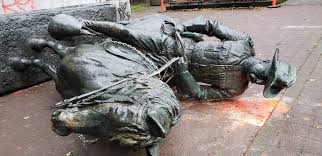
The odor Roosevelt – always near the top of the tiresome lists of “America’s Greatest Presidents.” On Mount Rushmore he functions as a permanent reminder of America’s historical amnesia – forgetting his racism, his militarism, his love of war. He wrote, in 1893, “No triumph of peace is quite so great as the supreme triumph of war” and in 1897, “In strict confidence . . . I should welcome almost any war, for I think this country needs one”. When a mob in New Orleans lynched a number of Italian immigrants, Roosevelt privately wrote to his sister that he thought the lynching was “rather a good thing”. Roosevelt even congratulated an American general who, in 1906, ordered the massacre of 600 men, women and children on a Philippine island. But he is seen as a “progressive” because as well as establishing the National Park system, he implemented certain regulations on unfettered capitalism, such as controls on trusts, on drugs and on food ingredients.
***
5: Junipero Serra
12/10/20:
US, California: statue of instigator of brutality against indigenous Americans who refused to convert to the usual brutality of monotheistic religion torn down on Columbus Day
Serra directed and founded the mission system in California that reaches from San Diego to Sonoma. These missions were religious and military outposts of Spain, established to colonize and Christianize Native California tribal peoples. The missions were basically prisons for natives where they were treated extremely brutally, with regular beatings, floggings, rapes of women and children.
On 17th October there was this report about the Archbishop of San Francisco performing an exorcism to cleanse the site of the protest.
An exorcism to drive evil spirits away, supposedly to protect the memory of a monster who set up a system of prison camps running the length of central and southern California in which to practice the doctrines of the Spanish Inquisition. No accident that the Native Americans burned the biggest one down. The priest tells the reporter that “the experts in the field tell me that Latin is more effective against the devil because he doesn’t like the language of the church.” Apparently the Devil doesn’t like the language of an institution that murdered and tortured and burned books all the way across Europe and around the world. The Devil doesn’t like the language of Cato the Elder and Julius Caesar, of Caligula and Nero? The Devil doesn’t like the language steeped in the deaths and enslavements of millions committed by barbarian Christians with their burning hatred of any knowledge that they couldn’t control or use to manipulate those whom they had subjugated? On July 16th the city had apparently decided to take down the statue but we can assume a Higher Being (The Pope? Mel Gibson? Bono? Lady Gaga?…one imagines some Catholic or other) intervened to preserve it. This obnoxious archbishop at the end of February 2021 warned against any laxity towards those who dared tear down his precious hero (here). Clearly turning the other cheek is always a recommendation to others, never for themselves, the representatives of God. And we too shall not turn the other cheek in response to them.
***
6: Victor Schoelcher
The toppling of statues in 2020 did not begin in the United States, but in the former French colony of Martinique, as shown above.
On May 22, 2020, in Fort-de-France, Martinique, a group of local youths toppled two statues of Victor Schoelcher. Why May 22nd? Because on that day in 1848, the enslaved refused to wait for the arrival of the commissioner from the French Republic sent to implement the decree of February 27 that abolished slavery. They declared themselves free. They saw no need to wait for freedom from an envoy from France. They knew the identity of their liberators. It was the Maroons, the rebels, the slaves who every day and every night resisted dehumanization.
This May 22nd, two young women took responsibility, in front of the cameras, for destroying the two Schoelcher statues. Quietly and firmly, they told the police, judges, and the state why they took action. “Schoelcher is not our savior,” proclaimed their manifesto, which also listed a series of demands. One of the young women was taken into custody and later released; the public prosecutor (a white Frenchman) announced an investigation and promised that the culprits would be punished. Condemnations of the action were immediate. In Martinique, they came from writers, intellectuals, historians, and elected officials. All the elements of language around history and colonial memories were present: accusations about the erasure of history and condemnations of youth who understand nothing about the writing of history. French President Emmanuel Macron strongly condemned the action, invoking the “greatness of France” and declaring that the act “sullies [Schoelcher’s] memory and that of the Republic.”
“White slave traders envisioned, conceptualized, encouraged, organized, trafficked in, enslaved, colonized, and thus justified the deportation of Africans. They established slavery and turned people into “objects.” They authorized the exploitation, torture, and death of bodies and of resources. They turned the belly of the Black woman into capital, prohibited them from becoming families, imposed the Black Codes and the Native Codes. They robbed, pillaged, and destroyed cities, universities, and temples, all in the name of a “superior” civilization.” – here .
***
7: General Lee
Lee statue to be removed
This recuperates the anger at the defenders of slavery and racism into a bureaucratic orderly form of control. Rather like when Iraqis, shortly after Saddam Hussein was deposed by US forces in 2003, spontaneously approached a statue of Saddam Hussein to pull it down. The Americans told them that they had no right to do that and that they’d face dire consequences if they did: the statue had to be pulled down by them, the proper authorities. In taking the initiative away from illegal direct action such state authorities can appear to be expressing disgust for past atrocities and repulsive ideologies. In the case of Confederacy statues, it’s a way of appearing remorseful for politically convenient reasons when such an admission has the least disturbing effect on the status quo and means absolutely nothing in the practical functioning of the cops, or the hierarchical division between black and white poor, a way of doing nothing to challenge the basis of the “mistake”, to ignore the political-economic reasons for it, so as to continue as before.
List of monuments and memorials removed during the George Floyd protests. And for an account of the toppling of a Confederate monument ahead of the 2020 wave of statue topplings, read this.
***
8: Haile Selassie and his dad
30/6/20:
Ethiopia: statue of Haile Selassie’s royal father pulled down
“In the eastern city of Harar, protesters have pulled down a statue of a royal prince – Ras Makonnen Wolde Mikael – who was the father of Haile Selassie, Ethiopia’s last emperor. The statue shows Ras Makonnen, an important military figure and former governor of Harar province in the 19th Century under then-Emperor Menelik II, sitting on a horse. In a recent interview with local TV station Oromia Media Network, Hachalu had said that people should remember that all the horses seen mounted by old leaders belonged to the people…”
Harar:
Before After
Statue of Haile Selassie destroyed in London
“The incident in Cannizaro Park, which is being investigated by police, was carried out on Tuesday evening by a group of around 100 people, according to an eyewitness. It appears to be linked to unrest in Ethiopia”
See “The Emperor” (about Haile Selassie) by Ryszard Kapuscinski: “It was a small dog, a Japanese breed. His name was Lulu . He was allowed to sleep in the Emperor’s great bed. During various ceremonies, he would run away from the Emperor’s lap and pee on dignitaries’ shoes. The august gentlemen were not allowed to flinch or make the slightest gesture when they felt their feet getting wet. I had to walk among the dignitaries and wipe the urine from their shoes with a satin cloth. This was my job for ten years.”
“…the officers…would read a proclamation demanding that His Benevolent Majesty give back the money that, they claim, he has been illegally appropriating for fifty years, depositing in banks around the world and concealing in the Palace and in the home of dignitaries and notables. This, they say, should be returned, because it is the property of the people, from whose blood and sweat it came. “What money are you talking about?” His Benevolent Majesty asks. “Everything went for development, for catching up and surpassing, and the development was proclaimed a success, was it not? We had no money for ourselves”. “Some development” cry the officers. All this is empty demagoguery, a smoke screen”. And they get up from their armchairs, lift the Persian carpet from the floor, and there under the carpet are rolls of dollar bills stuck together, one next to the other, so that the floor looked green…His Dignified Majesty calls me into his office and orders me to hide among his books the money he used to keep in his desk…The following day they come….and demand the return of the money, because, they say, it’s needed to buy flour for the starving. His Majesty, sitting at his desk, shows them the empty drawers. At which the officers spring from their armchairs, grab all those Bibles from the bookcases, and shake the dollars out…All this is nothing, say the officers. The rest of the money should be returned, especially the amounts in the Swiss and British banks…His Venerable Majesty [says] “All I have is a few pennies for the care of my ailing son in a Swiss hospital”. “Pretty pennies they are too”, answer the officers, and they read aloud a letter from the Swiss embassy which says that His Majesty has on account in banks there the sum of one hundred million dollars…Demonstrators were marching through the town, all sorts of rabble loitering about, cursing His Majesty, calling him a thief…“Crook! Give back out money”, they cried. “Hang the Emperor! Hang the Emperor!”. The majority of the money was never recovered.
***
9: Ulysses S. Grant
19/6/20:
San Francisco: Statues of Ulysses S. Grant and others pulled down
***
10: Jefferson Davis (Confederate president)
11/6/20:
US, Virginia: another monument in celebration of slavery destroyed
***
11: Leopold II
7/6/20:
Leopold II statue vandalized then taken down in Halle (Flanders, Belgium)
Many colonialists’ statues are vandalized in Belgium these days (with red paint, graffiti etc.), but it’s still rare to take them down or break them like in this case. A good start.
Leopold II: probably about 10 million people were killed in the Congo as this King of Belgium amassed a fortune there between 1885 and 1908. Some estimate that 80% of the population were killed/starved/died from European-inflicted diseases, but certainly a minimum of 50% . The very least people could have done with his statue was to do what they did in Bristol (see entry about Edward Colston, Bristol, UK, no.13 below) to the statue of someone who was “only” responsible for the deaths of 20,000 blacks, as opposed to Leopold II’s 10 million. Incredible that Belgium should have statues to a man responsible for the deaths of more black Congolese than the death of millions of European Jews by Hitler.
***
12: Josef Stalin
Stalin loses his head: statue of Russia’s former head of state decapitated by the Hungarian uprising of 1956:
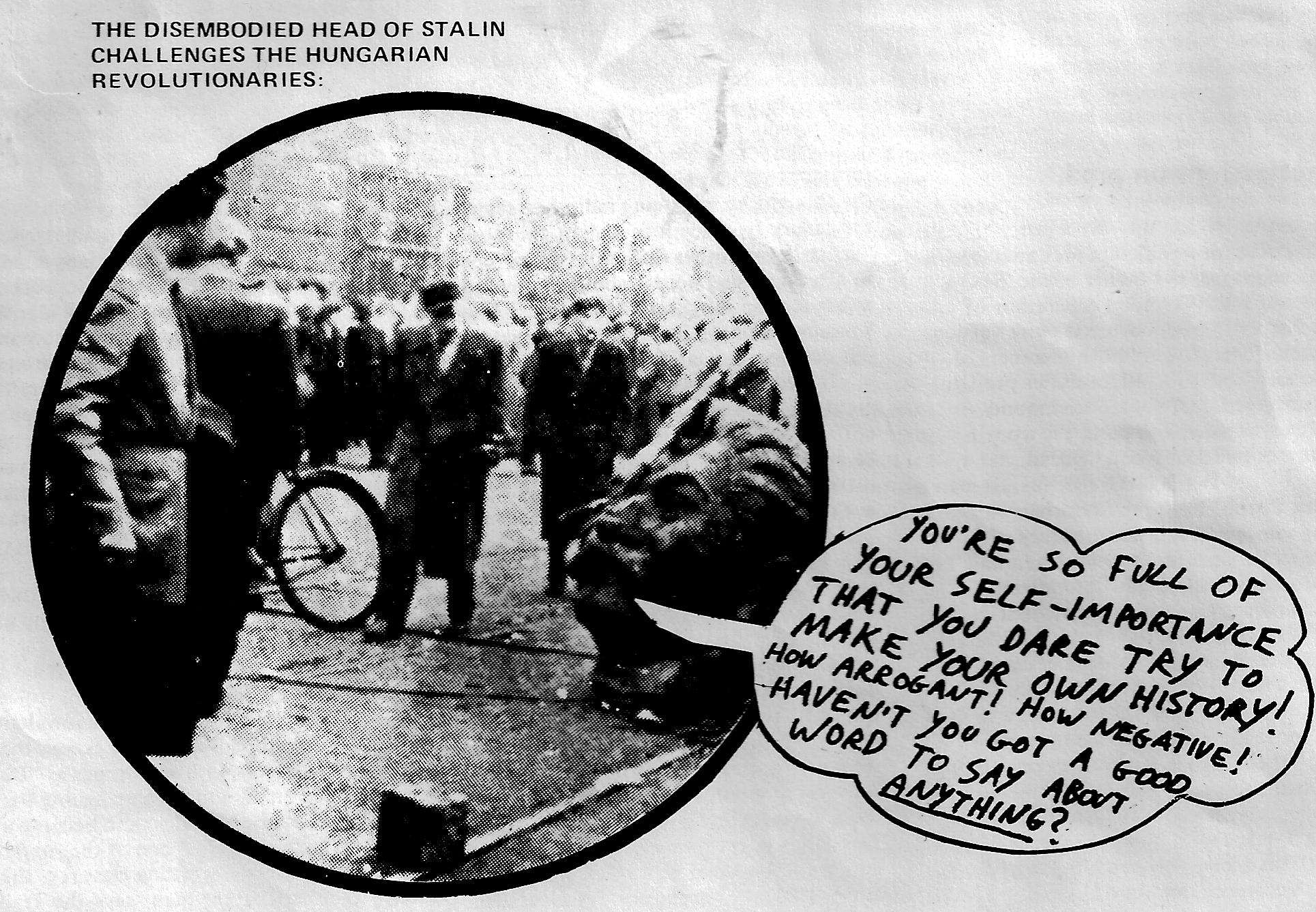
“One death is a tragedy – a million deaths is a statistic”, said Stalin. But nobody who claims to be against this society should make an equivalent of deaths, any more than make a hierarchy of them. Death and how people die can’t be reduced to the quantifiable – their deaths are as different as their lives, even if some aspects are measurable. For example, the British concentration camps in South Africa during the 2nd Boer War, killed over 26,000 women and children. Undoubtedly they weren’t as horrendous as, and had a significantly different history and consequence from, Auschwitz (including a far lower amount of deaths). But that doesn’t mean they didn’t have some comparable elements – cramming non-combatant populations into confined spaces and starving to death a specific selection of people, for instance. Whilst making equivalences of misery ignores and trivialises significant differences, making a hierarchy of misery ignores and minimises significant similarities. It’s impossible not to partly compare different situations, even if many aspects are not at all comparable. But in itself, this is not relativism. It only becomes an ism, an ideology, when a comparison is used to say situations, people and their histories are the same. Likewise, emphasising only the difference between situations becomes an ism, an ideology, only when this is used to dismiss comparing two situations which genuinely have aspects in common . “They’ve got nothing to do with each other” might be pertinent when comparing chalk and cheese, but not for many other comparisons. Struggle partly involves recognising that equivalence and hierarchy are 2 fundamentally intertwined aspects of the commodity form and of class power, of “recognising” people only in their reduction to exchange value, to a comparable quantifiable monetary equivalence on the one hand and, on the other hand, of an inability to see our common enemies and to recognise ourselves in each other.
“Today capital starves to death (or kills by easily curable diseases) 8 million children a year, and yet so few people do something to genuinely oppose this, even though such opposition would not – generally speaking – lead to torture and death, which such opposition would certainly have meant if anybody in Nazi Germany had done anything against the Nazis (and, despite this, there was opposition by the working class in Germany under Hitler – see, for example, this). This is certainly not to make an equivalence of all capitalist misery – which makes every misery as interchangeable and exchangeable as a commodity – as, say, “a quarter of wheat…exchanged for X blacking, Y silk, Z gold, etc.” (Marx, Capital). Mass murder is mass murder but body counts avoid understanding the historical and subjective meaning of the lives and deaths of those involved. But equally making a hierarchy that puts the killing of about 73% of Europe’s Jews at the top, the killing of about 73% of Hutus in Rwanda in the middle and the massacre of between 50% and 80% population of the Congo by Belgian imperialism at the bottom is obviously a euro-centric arrogance. Any radical hatred of capitalism can neither make a hierarchy of horrors nor impose a simplistic “objectivism”, in the name of some very general critique of the totality, on what are very different experiences of mass murder. Equivalence and hierarchy are two sides of the same ideological thinking inculcated by the commodity form.” – On German Guilt
***
13: Edward Colston
UK, Bristol: slave trader drowned, better 300 years late than never
“The Statue of Edward Colston…was designed by John Cassidy and erected in 1895 to commemorate Colston’s philanthropy. It was designated a Grade II listed structure in 1977….The Royal African Company, on whose board Colston sat, transported more than 100,000 slaves from West Africa to the Americas between 1672 and 1689; more than 20,000 of them died during the crossings.[1] Colston used his wealth to provide financial support to hospitals and schools throughout England, particularly in his home city of Bristol.” – here. Philanthropy: rob and murder the poor to give to the less poor to try to give them a belief in the philanthropic nature of those who rule over them rather than unite with the poorest to destroy their common enemies. John Cassidy, who designed this monstrous monument, “… attended art classes at night and won a scholarship to study in Milan, Italy. After two years, he moved to Manchester, England, where he lived for the rest of his life. He studied at the Manchester School of Art in 1883 and taught there in 1887. He created many public sculptures, especially war memorials, and exhibited at the Royal Academy, the Royal Hibernian Academy and in Manchester City Art Gallery. He was for a time assisted in his studios by John Ashton Floyd, a local sculptor.[1] For most of his career, his studio was at Lincoln Grove in Chorlton-on-Medlock. Many of his works remain in the Manchester district, notably those in the John Rylands Library, Deansgate: a group of three figures representing Theology Inspiring Science and Art “. I supply this information so as to hopefully inspire the further development of critiques of Theology, Science and Art by showing their mutual complicity in the development of capital, a development dependent on the murder of, in this instance at least, 20,000 blacks. Over 100 years later, the Holy Trinity of Theology, Science and Art have of course changed enormously, but even in their apparent oppositional forms – like Martin Luther King, Didier Raoult and Banksy – still significantly contribute to supporting class society whilst their reformist rebellion genuinely opposed some of the more horrific symptoms of it.
As for the horrendous black slave trade – this is often used to try to make white wage slaves feel guilty and that their history is utterly different from their fellow black proletarians. There may be objections to the use of the expression “wage slave” as if I was making an equivalent with the Atlantic slave trade, which is obviously one of the most abhorrent aspects of human history whose consequences continue to this day.
[By the way, to get some idea of how fundamentally sick the mentality of the American South was mid-19th century – and which continues in diluted form today – it’s worth looking at the psychologistic category “Drapetomania” – “a conjectural mental illness that, in 1851, American physician Samuel A. Cartwright hypothesized as the cause of enslaved Africans fleeing captivity”. In a sense it’s an extreme and crude example of all forms of psychologism, which obscure and falsify consciousness of the symptoms of distress caused by dominant social relations. Thus some people categorise the current spread of rumblings from the USA to a tentative global movement as “hysterical”]
A few weeks before these global beginnings of a movement arising like a bolt from the blue, in an argument with a white person weighed down with the guilty ideology of “white privilege”, a friend pointed out, “wage slave” has its own abhorrent history and context, and was a term used and defined by those who experienced it directly. It came to prominence in the horrors of the formation of the English working class in the late 1700s and early 1800s. As I have said, it is this different context and not an equivalence to … slavery …, but is a close relation and sharing in many respects the same origins and ruling elite. For those who lived through it (or more often than not, didn’t) it was an experience equally destructive, and arguments over definitions would have counted for little in either context. The slavery wasn’t absolute in technical terms, but the “liberties” afforded to the English poor were essentially fictional. In reality they were liberties afforded to the masters to not have any care for their workforce beyond the immediate needs of a season, the current productive cycle, or even just specific requirements of a particular day or week, etc. While a destitute mass of poor were forced off customary lands through legalised enclosures (or ‘The Clearances’ in Scotland) throughout this period (the last ‘Enclosure Act’ being in 1882), their poverty was criminalised, for example through the New Poor Laws (1834). Survival outside of formal work or domestic servitude (the single biggest sector) only became possible through criminality or in workhouses. It is well known that collective action was criminalised through the Combination Acts of 1799 and 1800, but perhaps less well known that almost every form of dissent or disobedience was also criminalised, and resulted in beatings, gaol, death or transportation to a colony in “indentured servitude” or “debt bondage”, both now universally recognised as forms of slavery in their own right.
While the image of this period is of “satanic mills”, most industrial labourers worked in sweat workshops or their own cramped accommodation. It may seem crass for the working poor of England to have compared their condition to that of the slaves in the colonies and Americas, but these figures perhaps illuminate the severity & magnitude of their situation:
The average age of death of a member of the labouring class in 1842:
Liverpool: 15 years old
Bethnal Green (London): 16 years old
Manchester: 17 years old
Leeds: 19 years old
(Report on the Sanitary Condition of the Labouring Classes, 1842)
All had endured a short life of hard labour from the age of 7 or 8 years old in a factory, earlier at home. Many were deformed by it. Almost all were killed by it. For example, girls working in the mills around me were notoriously disfigured by having been required to stand for 14-17 hours a day, six days a week from the age of around eight. Their hips remained narrow in puberty and many subsequently died in childbirth. The many girls working from a young age in mines operating the ventilation dampers or pushing coal trucks had deformed heads from their work. They had sight deficiencies from being in constant darkness and worked practically naked up until their death usually at work or in childbirth. I could fill hundreds of lines with similar examples. Some relief came in 1833 when in theory working days were reduced to 9 hours for those under 14 though as I’ve said, most work was in fact outside of formal factory settings.
A meticulously researched book I am currently working through and I recommend is EP Thompson’s “The Making of the English Working Class”.
So while you may find the term “wage slavery” objectionable … this term does not attempt to represent an historical equivalence to the Atlantic slavery, but does have its own specific historical and contemporary meaning, relevance and significance. For the people who experienced it (and in many places still do), it was a life as short, brutal and hopeless, as full of displacement, violence, death and as lacking in liberty as any on the planet. Far be it for me, or you, to deny this historical experience or its reckoning.”
***
14: Mahatma Gandhi
Damaged here
Protected here
Gandhi was useful for the ruling classes’ defence of the Brutish Empire because he opposed anything that might challenge dominant social relations. For instance, Gandhi used his reputation and leadership role to often disarm social movements in India when they threatened to get out of hand – he opposed strikes in the super-exploitative textile industries, even going so far as to threaten suicide if workers went on strike. This, along with his hypocritical nonviolent civil disobedience ideology, is one of the reasons why the upper middle class Richard Attenborough produced his film “Gandhi” quite explicitly to make propaganda against the massive riots that spread throughout the UK against Thatcher in 1981. Attenborough was later awarded a life peerage as a Baron by John Major, who’d been PM during Britain’s involvement in the Gulf War.
Gandhi’s “pacifism” did not stop him from supporting the Brutish in 1899 in the Boer War, volunteering to help them and organising an ambulance corps. As he said, “As long as the subjects owe allegiance to a state, it is their clear duty generally to accommodate themselves, and to accord their support, to the acts of the state”. When Gandhi was organising a mass march in South Africa in 1913, to obtain rights for Indians there, the white railway workers went on strike over pay and conditions. Gandhi immediately cancelled his march, saying that civil resisters should not take advantage of a government’s difficulty. On the outbreak of the First World War, Gandhi actively recruited for the Brutish war effort, despite his ‘pacifism’. Gandhi even refused to support a mutiny of a section of the Hindu Royal Garwhali regiment – who were brutally punished for the mutiny – when it refused an order to machine gun unarmed rioting muslims, saying he wouldn’t want soldiers in an independent India to refuse his orders to shoot if that became necessary!!!!!(Le Monde, 20th Feb. 1932).
On the outbreak of the Second World War, he publicly pledged not to embarrass the British, and would lend moral support to the Allies.
His usefulness for Brutish capital is shown by the fact that independence insured that Brutish investments remained intact. And this recognition that giving up direct control of an area of the world did not entail giving up economic power was a model for the end of the Brutish colonies everywhere. As long as the money was coming in, it didn’t matter if India, or anywhere else, was “self-governing” (ie remained within the sphere of Brutish capital accumulation). “Pacifism”, in Gandhi’s version of it at least, is the last refuge of those who want to defend and/or submit to the violence of hierarchical social relations, giving it the appearance of opposing violence, but in fact only opposing the violence of those who contest this violent world.
https://www.bbc.com/news/world-africa-32287972
“A man has appeared in a South African court in connection with vandalising a statue of Mahatma Gandhi. “He was found while painting the statue with white paint and arrested,” police spokesman Kay Makhubele told the BBC. He was part of a group who demonstrated near the statue on Saturday with placards reading: “Racist Gandhi must fall”. This is the latest in a series of protests in South Africa calling for the removal of historic statues. While the man who led India to independence is widely regarded a man who stood for peace, some South Africans have accused Gandhi of working with the British colonial government to promote racial segregation. He lived in South Africa for 20 years and campaigned for the rights of Indian people there. The rest of the South African protesters, who managed to escape, wore caps with the governing African National Congress (ANC) but the party has distanced itself from the incident and condemned the defacing of the statue.”
***
15: Other information about the anti–statue movement in South Africa, 2015
“When a black South African student threw a bucket of excrement over a statue of Cecil Rhodes, it kicked off a protest movement that is shattering the way the country sees its past. On the morning of 9 March, Maxwele travelled by minibus taxi out to Khayelitsha, picked up one of the buckets of shit that sat reeking on the kerbside, and brought it back to the campus of the University of Cape Town (UCT), where, in 2011, he had gained a scholarship to study political science. He took it to a bronze statue of the 19th-century British colonialist Cecil John Rhodes that held pride of place on campus, just downhill from the convocation hall. Rhodes had been one of the main architects of South Africa’s segregation. “Where are our heroes and ancestors?” Maxwele shouted to a gathering, curious crowd. Then he opened the bucket and hurled its contents into Rhodes’s face.” (here)
More here. The student who led this improvement said,“How can this statue still stand on a road called Madiba Circle? By doing that we are making history beautiful when it is not.” But clearly the powers that be are more aware of the ugly connection between Mandela (Madiba) and Rhodes than this student. Maybe, for instance, he’s unaware of this posh hotel (a snip at over $200 a night):
April 2015: statue of Martinus Wessel Pretorius, South Africa’s first (white) president, and statue of Andrew Murray, a white pastor, improved
Andrew Murray: “I have said many times that religion and education are wasted on these savages. Sir Theophilus Shepstone (who could speak several black languages) said that you should leave the blacks alone. Don’t feed them, don’t clothe them. Give them no work. Do not attempt to educate them or try to convert them to Christianity. Have NOTHING to do with them.” Now if only these whites had left the blacks “alone”, avoided taking the blacks’ land, avoided stealing the food from them, avoided forcing them to wear the clothes they wanted them to wear, avoided extracting surplus value from their labour, avoided conditioning them into ruling class culture and converting them into the ideology of sacrifice and had had NOTHING to do with them…if only.
SK writes:
“Now that the statue [of Rhodes] has been removed, a demand which required little risk on the part of supporters and little cost to institutional power, things are taking an interesting turn down at the Universtity of Cape Town. The mass of students and their representatives seem to have been satisfied with this spectacular gesture, whilst an extremist wing has vowed to continue occupation of the administration buildings in line with their declaration that the statue was ‘just the first step’. The bureaucrats in charge have now warned them to vacate the premises and a confrontation is inevitable unless the students fail to back up their radical rhetoric in action.
Obviously the bosses, and the majority of students and other spectators who supported the removal of the statue, are now interested in returning the action into the abstract realm of the ‘transformation’ process that measures the image of today’s institutional racism with that of the past. The hardcore seem determined not to allow this evasion to happen too easily.iv
***
16: Winston Churchill
Undoubtedly this shithead was a racist. For instance, in 1937 he said to to the Palestine Commission, “I do not admit… that a great wrong has been done to the Red Indians of America or the black people of Australia. I do not admit that a wrong has been done to these people by the fact that a stronger race, a higher-grade race, a more worldly wise race to put it that way, has come in and taken their place.” But though Churchill was a racist, he was far worse than that. Besides, the vast majority of heads-of-state are racist and enact racist policies, so this seems a little too easy a criticism.
Firstly he was a bourgeois aristocrat through-and-through, having won his political credentials as Home Secretary in sending in troops into the South Wales town of Tonypandy during the miners’ strike there of 1910-11 (possibly 1 or 2 people were killed, but all evidence of these possible killings seems to have been repressed). When Churchill died in 1965 his death was celebrated by South Wales miners whose collective memory of the events had lasted more than 50 years.
 Churchill at the siege of Sidney Street, 1911, where immigrant anarchists who’d probably killed 3 cops in the robbery of a jewellers, were themselves killed, possibly burnt to death
Churchill at the siege of Sidney Street, 1911, where immigrant anarchists who’d probably killed 3 cops in the robbery of a jewellers, were themselves killed, possibly burnt to death
As Minister of Munitions at the end of World War I he supported the gassing of the Kurds, a war in which the British state fought a violent movement for independence, using both gas and bombings against the Kurds – “Churchill was particularly keen on chemical weapons, suggesting they be used “against recalcitrant Arabs as an experiment”. He dismissed objections as “unreasonable”. “I am strongly in favour of using poisoned gas against uncivilised tribes… (to) spread a lively terror” (here).
During the General Strike of 1926, Churchill was reported to have suggested that machine guns should be used on the striking miners. He also claimed that Mussolini’s fascism had “rendered a service to the whole world”, showing the “way to combat subversive forces”, adding “If I had been an Italian I am sure I should have been whole-heartedly with you in your triumphant struggle against the bestial appetites and passions of Leninism… [Italy] has provided the necessary antidote to the Russian poison. Hereafter no great nation will be unprovided with an ultimate means of protection against the cancerous growth of Bolshevism” (here).
In WWII he supported the gassing of the Germans (here). When in 1942 the popular Quit India Movement threatened to disrupt the war effort, it was brutally put down with public shootings and mass whippings, torturing of protesters and burning of villages, leading even bourgeois observers to make comparisons with ‘Nazi dreadfulness’. And when he requisitioned the boats that distributed rice and other food to various parts of Bengal, and Mountbatten reacted by offering 10% of the space on British battleships for this distribution, Churchill withdrew 10% of the battleships. At least 3 million Bengalis died, a significant amount due to these policies (though there were also other factors). Even the Secretary of State for India, Leo Amery, remarked: “On the subject of India, Winston is not quite sane … I didn’t see much difference between his outlook and Hitler’s.”
He also smashed the Greek resistance in 1945 and even suppressed bourgeois democracy in Guyana.
So saying he was a racist is about as powerful as saying Hitler was not a nice bloke.
 Churchill statue improved, London, May 2000
Churchill statue improved, London, May 2000
***
17: General Baquedano
12/3/21:
Chile, Santiago: riots as statue is removed for renovation after several repeated attacks
“General Baquedano is a symbol of Chilean fascism, mainly because of his role in the “acquisition” of territory in the north and south of Chile. Let us also remember that under the statue is the tomb of an “unknown soldier” that symbolizes all the people killed in the war of the Pacific, a conflict of foreign interests that caused the death of thousands of poor people from Bolivia, Peru and Chile to increase the wealth of the oligarchy of these countries.” – from here
***
18: Attacks on Religious Statues and symbols
8/11/19:
Chile, Santiago: Jesus helps out on the barricades
“The abolition of religion as the illusory happiness of the people is the demand for their real happiness. To call on them to give up their illusions about their condition is to call on them to give up a condition that requires illusions”
– Karl Marx, “Introduction to A Contribution to the Critique of Hegel’s Philosophy of Right”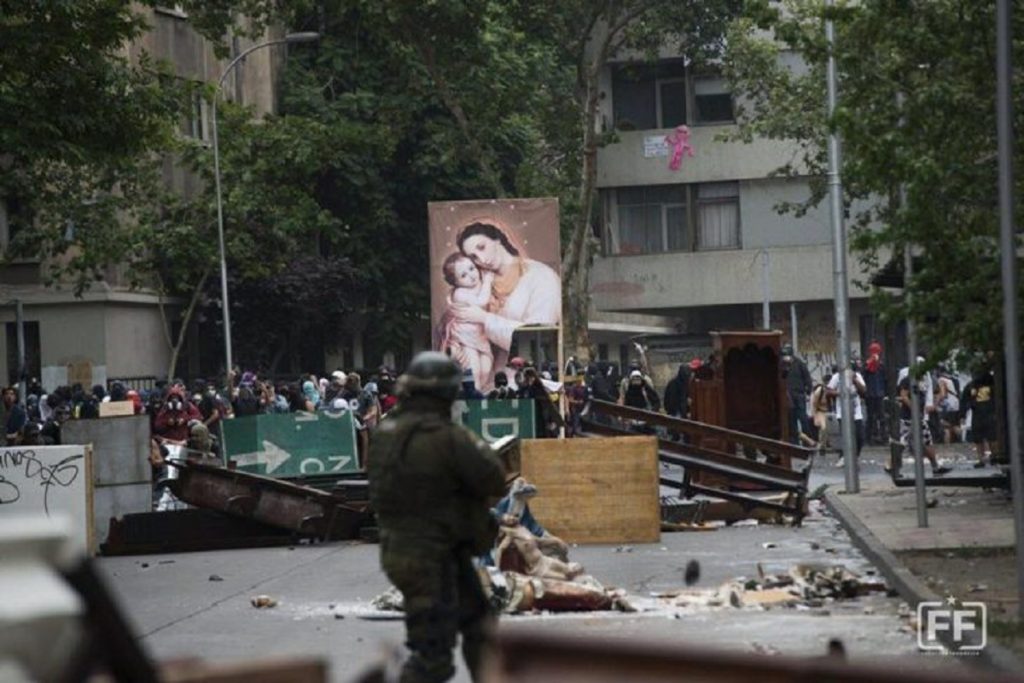
Below:
Graffiti on outside of church, mid-70s
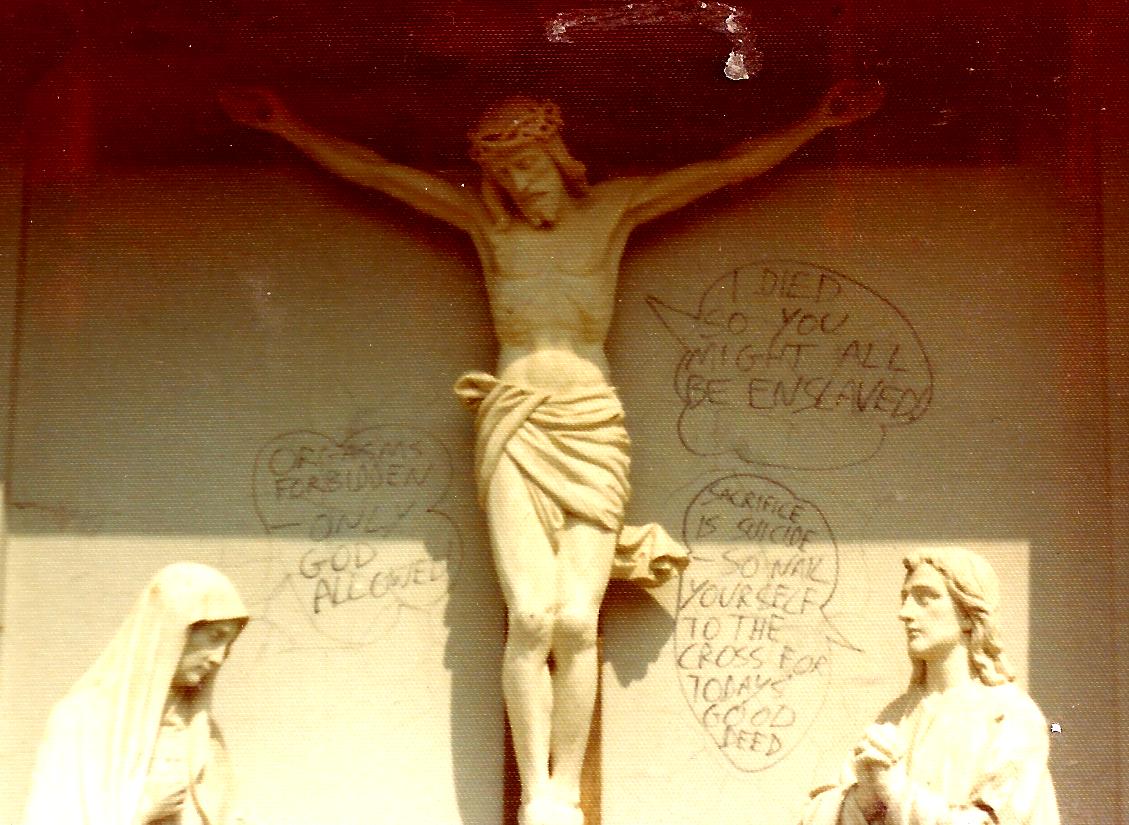 Mary : Orgasms forbidden – only God allowed
Mary : Orgasms forbidden – only God allowed
Jesus: I died so you might all be enslaved
John: Sacrifice is suicide – so nail yourself to the cross for today’s good deed
This graffiti was quickly covered over, but then it was replaced with the following graffiti, later written over the paint:
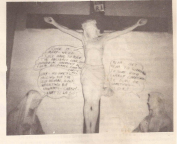 Mary: Hey – no-one’s falling for the self-denial, guilt-inflicting bit nowadays – Christ! – what’ll we do?
Mary: Hey – no-one’s falling for the self-denial, guilt-inflicting bit nowadays – Christ! – what’ll we do?
Christ: Cool it, Mary – we’ll just have to push the abstract love, universal harmony, total acceptance line – that’s all
John: Yeah – get ‘em to surrender to some high-energy charismatic guru or something – ok ?
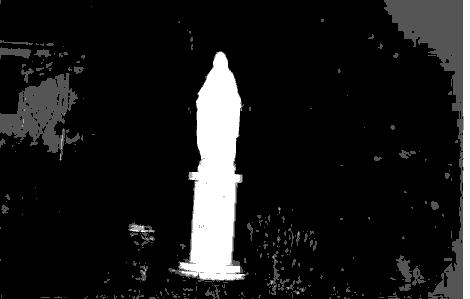 Photo taken at night during the 1970s – graffiti on the base of a statue of Mary in the garden of a convent; it’s impossible to read but it says “Gentle nun – this image of loving tenderness is but bait on the hook of guilt, renunciation and submission – KICK THE HABIT!”
Photo taken at night during the 1970s – graffiti on the base of a statue of Mary in the garden of a convent; it’s impossible to read but it says “Gentle nun – this image of loving tenderness is but bait on the hook of guilt, renunciation and submission – KICK THE HABIT!”
***
19: War memorials
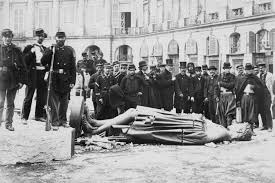 The greatest work of art of the 19th century: the destruction of the Vendôme Column, symbol of Napoleonic imperialism, during the Paris Commune, May 16th 1871, the 150th anniversary of its occurence coming up soon. Following the suppression of the Commune, the Vendôme Column was rebuilt in 1873. (See this attempt to recuperate this destruction into a modern art gesture which was either merely an expression of the art of provocation or simply naive)
The greatest work of art of the 19th century: the destruction of the Vendôme Column, symbol of Napoleonic imperialism, during the Paris Commune, May 16th 1871, the 150th anniversary of its occurence coming up soon. Following the suppression of the Commune, the Vendôme Column was rebuilt in 1873. (See this attempt to recuperate this destruction into a modern art gesture which was either merely an expression of the art of provocation or simply naive)
Many people get more upset by the “desecration” of war memorials than by any other expression of vandalistic anger. It’s as if the grave of their loved ones had been attacked, even if their loved one may be reduced to “The Unknown Soldier”.
But war memorials are not there to show the horror of imperialist war but to praise it, to praise the dead for the defence of “our freedom”, as if the world of wage slavery and commodity consumption is the epitome of freedom, as if hierarchically-determined war wasn’t there to advance the capital accumulation of one’s “own” ruling class and isn’t inherent in the logic of wage slavery that epitomises what “freedom” means for this society. Endless songs are recorded attacking the senselessness of war, but attacking the falsification of this senselessness in the form of a war memorial is considered bad taste.
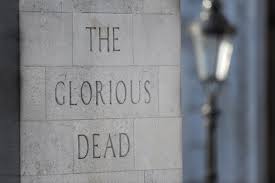 The Cenotaph, appropriately standing in the middle of Whitehall, the centre of the UK’s political class.
The Cenotaph, appropriately standing in the middle of Whitehall, the centre of the UK’s political class.
As if by sacrifice one achieves “glory”, because life in this society is so inglorious. On the London Mayday demo in 2000, the Cenotaph was tagged with “Why glorify war?” causing a scandal amongst all those who embrace and reinforce the deathliness of a world which is so hard to live in.
In this upside down world respect for the dead and the total absence of respect for the reasons for their inglorious deaths is the logic of respect for the death of all sense and of any pretense to rationality, the logic of capital. It is somehow seen as an atrocious lack of respect for a “tragedy” to express disgust for the whole bloody show. The miserable justifications for this “tragedy” are always endowed with some spurious higher purpose (duty, the glory of sacrifice, dying for ‘our freedoms’), when daily tragedies in the present are largely ignored or even justified because the real purpose is capital accumulation and social control. Those who have died – and continue to die – in the class war, the war that genuinely struggles for ‘our freedom’, are buried under amnesiac memorials, memorials that dress up the reduction of human beings (mostly men) to commodified pawns in the rulers’ game in the sombre colours of a sombre gory glory which deserve a sombre minute’s (or, indeed, several sombre years’) silence.
Look at how some of the ruling scum parade themselves on so-called “remembrance day”, where almost everything is forgotten about war because a minute’s silence is respectable society’s way of saying that one has nothing to say. Look how sections of the warmongering ruling scum show their love of death every year on “don’t remember anything” day:
The more grim-faced and serious they appear the more they aim to represent a sense of tragic but necessary sadness that they present capitalist war as. By this image they hope to entice those at the sharp end of the hierarchy to sacrifice themselves for this serious cause, the cause of defending a country that they are meant to think is theirs, a country that’s the bloodstained property of those who get the real bloody work of defending their shit country to be done by those who have no country.
See, for example, this, which tries to genuinely remember.
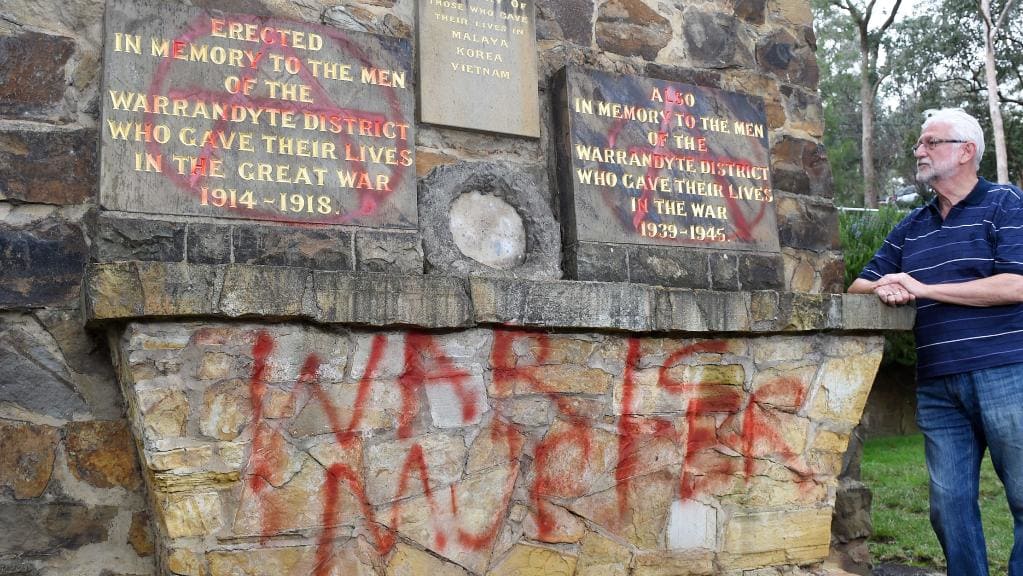
“If I should die think only this of me:
That there’s some corner of a foreign field
That is for ever a truly repulsive poet.”
(slight change from this)
UK, Sussex: yet another mindless act of mindless denunciations of mindful vandalism…UK, Slough: war memorial improved…UK, York: large ceramic poppy smashed…UK, Angus: another critique of the art of war…Yorkshire: if only real naval warfare (and all the other forms) could be wrecked so easily …France, Vendée: Petain’s tomb vandalised…UK, Kent: poppy display filled with foaming water denounced in traditional knee-jerk clichéd manner…Hertfordshire: and another…New Zealand, Otago: memorial to bloody needless (except for the ruling class) war vandalised…UK, Bolton: minor attack on falsified memory of mindless and devastating acts of violence…N.Ireland (Derry): sacrilegious horror shock aaaagh!!!!…UK, Edinburgh: deplorable maliciously violent celebration of war amnesia improved…Hertfordshire: and another…UK, Essex: WW1 false memorial syndrome receives health improvement…UK, Ripon: disrespect for those who made ultimate sacrifice in submission (forced or voluntary) to their masters… UK, Hartlepool: despicable and disgusting MP shows complete lack of respect for critique of war memorials designed to ensure false memories…UK, Antrim: militarism critiqued…UK: Southampton: moronic monument to militarism mended by mindless moron…Great Yarmouth: and yet another sign of lack of respect for moronic militarism…Eire, Clare: £70,000 mass slaughter memorial vandalised… UK, Ross-On-Wye: yet another refusal to respect militarism responded to with mindless angry defence of the use of cannon fodder…Somerset: and yet another…UK, Merseyside: lest we forget the thousands of soldiers who lost their heads in WWI…UK, Fife: and another…and more …and yet more…and yet more again
A Twitter post saying “It doesn’t matter how angry you are, graffiti on a war memorial is inexcusable and damn right rude” above this photo:–
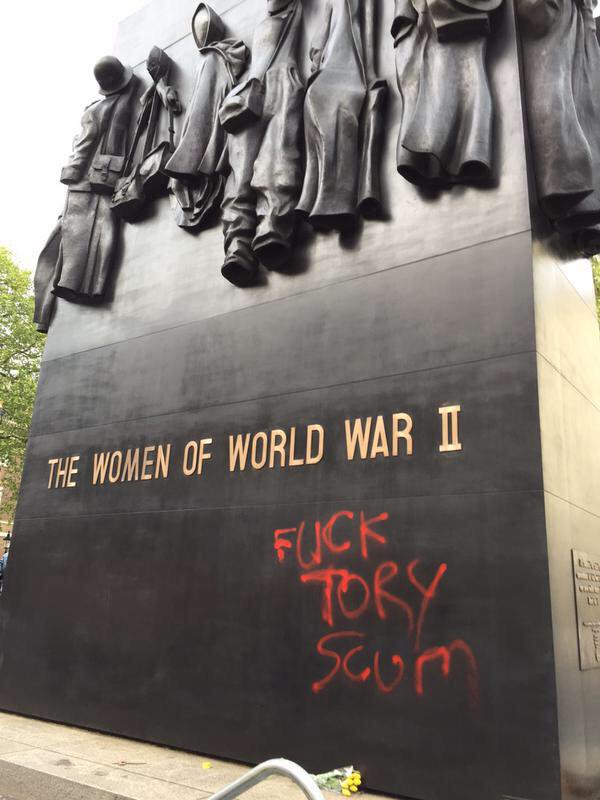
*
More information about events around war memorials in the UK inspired by the attacks on statues in the US following George Floyd’s murder:
https://www.bbc.com/news/uk-england-london-52977088
https://www.bbc.com/news/uk-england-bristol-53034357
https://www.bbc.com/news/uk-england-humber-53036940
https://www.bbc.com/news/uk-england-leeds-53034139
*
This article, focusing on Germany, makes out that memorials can be a way of criticising the past of a nation, and of the masses of people who benefited from the brutality of this past, suggesting how “we” need to apologise for this past in the form of memorials. Whilst saying “One doesn’t have to serve an unfair system directly to be complicit with it. Following the crowd through indifference, opportunism or conformism is also form of complicity” is true, the author claims that the oh-so-conscious people of present-day Germany do not do this: the author congratulates and valorises current day Germany, its democracy and element of guilt for the crimes of the Nazis in a somewhat complacent self-satisfied manner. She talks of “taking the perspective of the victim, the oppressed… the humiliated” as if the vast majority of people weren’t in some way victims, oppressed and humiliated, though at different levels of the hierarchy of victimisation, oppression and humiliation. Apart from the the fact that alienated production and consumption in Germany is as repressive as everywhere despite its accumulated wealth (in part built on the massive post-war subsidies of the Marshall Plan) , the author also ignores the fact that all advanced nations function partly on the basis of their exploitation of the “Third World” in the present, not necessarily through direct imperialism but through investment. Reducing the horrors of a nation to its past and the easy “method” of apologising for this past helps ignore the present as if the present was one of a great democracy reconciled to its guilt [v] about the holocaust, as compared with countries like Britain, still defending the horrors of the Empire. Complicity with present horrors, confrontation with which would entail an anti-capitalist perspective, is conveniently forgotten by focusing purely on the most obvious horrors of the past, and assuming the fact that refusing to allow the past to dominate the present can be reduced simplistically to doing so through monuments and apologies.
***
20: Thatcher
In July 2002 an unknown theatre producer (or so he described himself in court) chopped off the head of Margaret Thatcher, unfortunately only in statue form – a symbolic act that undoubtedly pleased millions.
For more substantial mass attacks on Thatcher see this and chapters 11 onwards here
***
21: Sigmund Freud
Above was written by a friend at the same time I wrote the graffiti below
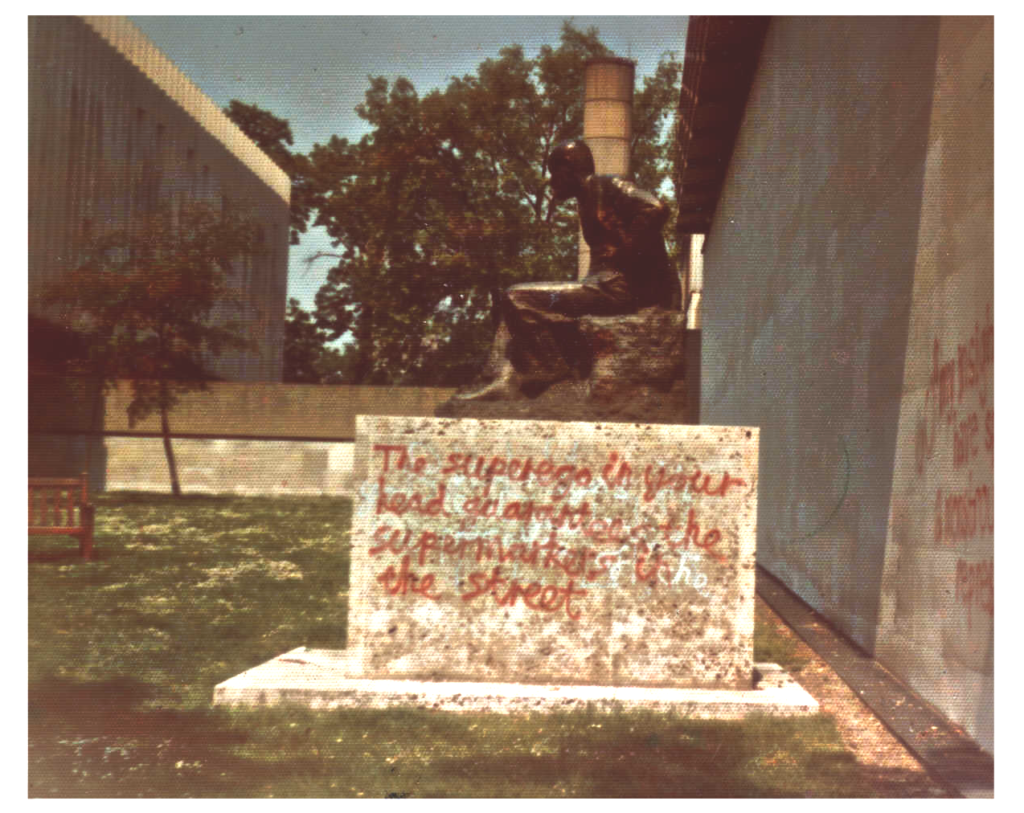 The superego in your head guarantees the supermarkets in the street
The superego in your head guarantees the supermarkets in the street
***
22: Queen Victoria
Left: Queen Vic unamused, Brighton Right: Queen Vic unamused, Montreal March 20 2021
Brighton September 1984: a trip to the seaside in support of the miners
“We arrived, about 12 of us, men and women, in Brighton after going a round about way to avoid the cops’ possibly turning us back. It’d been an unusually long drive in the van, considering the normal short distance. We parked the Southwark Unemployed Centre van over half a mile from the beach, drank a bit of wine and headed off, mid-morning, towards the sea front for the demonstration, armed with spray cans and pamphlets. There’s a statue of Queen Victoria in the park so two of us went down to the statue and one gets up high to shove a black flag in her hand, whilst the other one at the bottom spray-paints, “We are all abused”. Cops come along and, without radioing for back-up, attempted to arrest him, holding him in an arm lock from the front round his neck and at the side. The others came along and one of them bit one cops hand, whilst others pushed the other cop out of the way, and the guy ran like fuck through the narrow streets and everybody else did likewise – everyone gets away. As soon as the spray-painter meets up with one of his mates, she gives him her jumper so he looks different, whilst the cops go round Brighton peering out of their cop car in vain all round the demo for the crowd who assaulted them. No one gets nicked, and we continue the day in good spirits, elated by this small victory, handing out subversive pamphlets and chatting and arguing and feeling good, whilst most other people felt pretty bored.” [vi]
Montreal, March 20th 2021: “We do regret that we were unable to topple the statue tonite, as those cool kids did back in August 2020 to the John A. Macdonald statue…Just put the British Royal Family, all of them, into a limousine, give them a drunk French chauffeur and let nature take its course.”
***
23: Karl Marx
Chinese Premier Chairman Hua lays a wreath at Karl Marx’s grave in Highgate, North London, 1979
Hua’s visit vii to Marx’s grave viii was announced in the London evening papers the day before he was due to visit at 10am the next day. Me and a friend went along there in the pouring rain at about 2a.m. to graffiti the sculptured tombstone. Over the carved inscription, “Philosophers have merely interpreted the world in various ways; the point, however, is to change it”, we wrote “Leninists have merely re-organised capitalism in various ways. The point, however, is to slit their miserable throats” and on the side we wrote: “Discos in Peking won’t distract the Chinese proletariat” and other stuff. We got soaking wet, but were pleased. Next day, in the papers we read “In the past, Marx’s grave has been vandalised with graffiti – but this time it was spotless”. I was furious – we’d got soaked for nothing. So, intent on some form of retribution, I – this time alone – got into the cemetery the next night and stole the wreath that Hua had put there (I was also slightly uplifted by the fact that they hadn’t managed to completely wash off the paint). The wreath was basically a plastic tyre-type thing with individual roses put on little bits of wire and stuck into the “tyre”. I covered my flat with about 250 roses all over the place, before they all dried and shrivelled.
***
24: Sculptures of an abstract nature
8/6/20:
Vera Cruz: about 50 anarchists attack street art …Video showing the destruction of the idiotic street art.
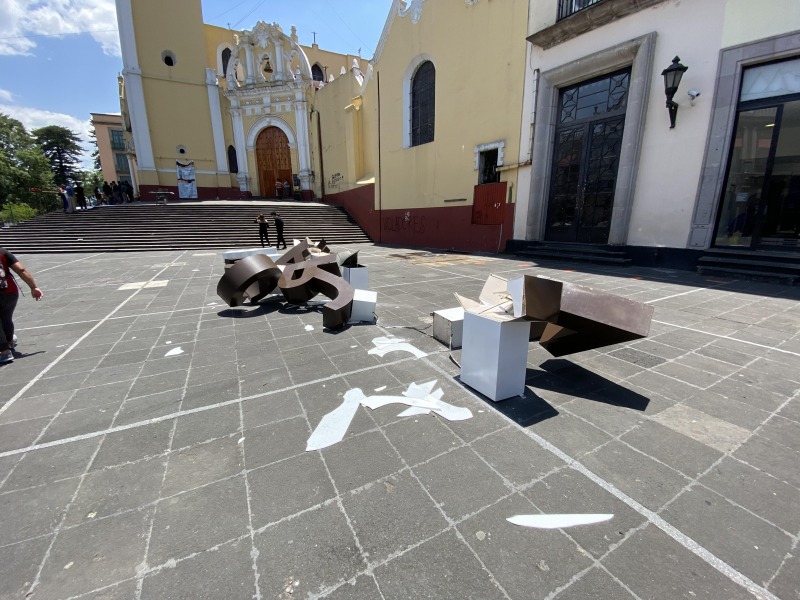 Vera Cruz: the realisation & suppression of art and the art of realisation & suppression
Vera Cruz: the realisation & suppression of art and the art of realisation & suppression
Sculptures of a more abstract nature are a symptom of the valorisation of the uniqueness of artistic representation – a unique product is valued just because it’s unique, regardless of any other qualities it may have. Though, being open visually to anybody who passes by, it doesn’t directly accumulate wealth for the authorities that paid for it (except maybe because it contributes a bit to the tourist industry), but it’s valued by the authorities that bought it out of taxpayers’ money because the law of supply and demand values the unique, but only the unique submissive to social norms. As you drive or walk along the alien city you’re meant to find consolation for the intensified stresses of the increasingly mad world in the little bits of anesthetic aesthetics dotted around the place (in France, the middle of roundabouts have increasingly got rid of bushes, grass and trees and replaced them with sculptures and statues, almost invariably abstract). They distract the eye from the strangers passing by who remain increasingly strange, people now increasingly hidden behind masks, as if even the banal “masks” people are forced to put on in order to play the roles needed to survive in this image-dominated world were still too transparent for the opaque scum who rule us.
In the mid-1980s in Islington, London, artists and staff belonging to the avant-garde Air Gallery in collaboration with the local left-wing Labour council, set up an open air exhibition of junk sculpture consisting of a tower of broken washing machines and tyres on a bit of green space used by the tenants of the council-owned Hartnoll Estate in Clerkenwell. The middle class mentality behind it was the ideology of bringing culture to the plebs: the locals were not asked for their consent – they weren’t even considered worthy of being soft-soaped. As a result, artists were attacked and occasionally roughed up by the estate’s residents for nicking tenants’ space and the sculpture was attacked also [ix]. Amongst other reactions, this brought down upon them the keyboard wrath of the Guardian’s art “critic” Waldemar Janusczak with the usual knee-jerk denunciation of philistinism (often those who ideologise art deliberately use simplistic equivalents, amalgam techniques, to try to associate an attack on art with fascistic State repression, like comparing the act of an individual with what the Taliban did to the Buddhist statues, typically with the accusation of ‘philistinism’). As if the imitation, with none of their original subversive aim or content, of the ready-mades of Duchamp or other Dadaists 70 years previously, the idolatry of an empty aesthetics and the total ignorance of the history of the demise of art was something other than philistine. A local resident wrote in response to The Guardian article, “…We object to the setting up of public sculpture in our community without local people being consulted. It is a peculiarly bourgeois notion that the individual artist has the right to appropriate without our consent the public space in which we have our social being for his or her own artistic statement. This is middle class cultural imperialism with a vengeance. What makes the use of the site doubly galling is that Islington Council has refused to allow ut to turn it into a public garden. The Great Socialist Republic want to turn property developer and put up an office block there”. And added, in relation to the artwork itself, “Marcel Duchamp said it all with rather more wit and elegance many years ago.” Clearly the ideology behind such sculptures is to hide the fact that artists are the avant-garde of gentrification, business and increased rents for everybody (see this).
In 2001 an anonymous art critic burnt down Willow Man”, also nicknamed “Angel of the South West”. Over 5 years later Sir Antony Gormley, creator of the massive Angel of the North, deliberately had a sculpture of his burnt as some performance art-cum-clip of a TV film. When destruction of sculptures is profitable and is hierarchically controlled, it’s art. Otherwise it’s considered to be vandalism and may henceforth get you a 10-year stint in prison. In 2019 a tediously banal sculpture by the aforementioned Gormless was vandalised (ie slightly improved) on the campus of Newcastle University. “People have quite mixed feelings about it. Some are saying it’s vandalism, but more people are saying that the piece itself felt like a bit of an intrusion on campus.”
This Financial Times article, whilst obviously having no critique of capitalism, still has some interesting things to say: “These days, outdoor art is all about having a bigger erection than the town down the road….Antony Gormley is to blame. Him and Gateshead council. Ten years ago the town put up the £880,000 post-industrial Icarus designed by the sculptor. Promoters figured it would bolster local pride battered by the decline of manufacturing. The wheeze succeeded beyond their wildest dreams. The statue created an instant visual shorthand for Gateshead. It is widely and wrongly credited with sparking a wave of regeneration. Local people were really responsible. These days, the only complaints about the Angel are that it should be bigger. Good for Gateshead. Bad for everyone else. We are now exposed to marketers wishing to copy the Angel’s success. It started in 2000, when a public body erected a 12m willow figure by the M5 in Somerset. An anonymous art critic burnt down this “Angel of the South West”. … In 2002, a Cheshire consortium unveiled “Encounter”, a.k.a “The Angel of the North West”, next to the M62. This banal 30m sculpture of two acrobats symbolises the equally anodyne idea of “business and the community working together”…. Mark Wallinger’s proposal for a huge white horse echoes less obtrusive chalk hill archetypes. Its aim would be to promote Ebbsfleet, a Kent new town. Continentals coasting past on Eurostar are more likely to assume it advertises whisky or a horse-meat hypermarket. But even now jealous council officers and developers are closeted in fuggy meeting rooms across the UK devising their own big statues. They should be resisted. The term “public art” applied to these monuments is a misnomer. The public has not asked for them. Instead, they are a way to foist unsubtle messages on ordinary people, as demonstrated by the well-funded public art programme of pre-invasion Iraq. At best, big sculptures are what the Financial Times architecture correspondent Edwin Heathcote calls “one-liners”. Once you have registered the allusion to manufacturing embodied in the Angel of the North’s aeroplane wings, you have plumbed the shallows of its meaning. My colleague complains of the “Disneyfication” of landscape and cityscape. Our skyline should be punctuated by beautiful, functional buildings, he argues, not contrived landmarks chucked up to make a point. A further telling charge is that big sculptures are a cosmetic response to a real loss of identity in modern Britain. Locally rooted industries have collapsed and the cloned shop fronts of store chains have colonised high streets. The latticed steel rods of “Aspire”, for example, refer to lace- and bicycle-making. Both trades are defunct in modern Nottingham. The developers of Ebbsfleet will meanwhile raise their statue in prophylactic voodoo against the anonymity of the commuter belt to which they are adding. Personally, when I look out of a train window I want to see a real horse, not a huge, artificial one. “We are disturbed by the trend for very large monuments that can detract from the landscape,” says Neil Sinden of the Campaign to Protect Rural England, adding: “These initiatives need to be in scale and say something genuine about the place where they are located.” Small statues of John Betjeman at St Pancras and Eric Morecambe in Lancashire tick both boxes. At the very least, we should resist attempts by artists to use the current mania for monuments to extend their hegemony in talking nonsense. Explaining his plan to display members of the public on the fourth plinth at Trafalgar Square this week, Mr Gormley said: “Through elevation on to the plinth and removal from the common ground, the body becomes a metaphor, a symbol, and allows us to reflect on the diversity, vulnerability and particularity of the individual in contemporary society.” Amazingly, no one threw fruit at him. Occupants of the plinth may not escape so lightly.”
The definition of “genuine” in the sentence “These initiatives need to be in scale and say something genuine about the place where they are located” can be seen by the fact that smallish monuments to the frenetically frivolous Eric Morecambe and the easy-listening rhymes of John Betjeman (who once said that when adverts rhyme they’re poetry) are considered positive and genuine. Encapsulating “something genuine about the place where they are located” in role models for the tediousness of traditional conservative British culture is no more critical than Prince Charles’ criticism of modern architecture (who was helped in articulating his criticisms by a former pro-situ Dave Robbins using the situationist critique of urbanism minus the essential to influence Prince Charles). Partial critiques always end up being incorporated into dominant discourse. If a future society without money or celebrities would want to encapsulate aspects of its past history in some constructed form it will refuse to look simplistically towards some nostalgic reminiscent form of this past, like Orwell’s “Coming up for air”. The point is who decides, how and with what content.
These sculptures of a more abstract nature reflect the domination of the world by abstractions and things and turn this into something positive x. Yet the disharmony of the modern city overwhelms us with a sense of chaos. This is primarily due to the competition between different property owners and businesses and state forces forcing us to look up, distract us and grab our gaze to be perplexed from every possible competing visual angle. Whole buildings have become “sculptures” whose only aim is to compete for citizen’s attention and make them feel small before the amazing engineering skills and technological flexibility of increasingly bizarre structures. Previous totalitarian states, religiously, mythically or ideologically inspired, created externally defined spatial “harmony” which the masses of submissive passive individuals were reduced to admiring as some monumental form that overwhelmed them and kept them separate but at least relatively calmly. But calm is the last thing you feel when walking through the “sculptures” of modern office blocks or living spaces. Should there ever be a successful reversal of perspective, a potentially harmonious form of space that does not reduce us to spectators, this would develop from the intersubjectivity of individuals constantly transforming their environment. This in accordance with their mutual will to meet their communal and personal needs and desires liberated from the hierarchical authority of the commodity economy and of those aspects of nature that pose an insurmountable danger (a danger only if they’re not held at bay in some way): “A valley of labyrinthine blues and greens, intertwining writhing streets, ladders and bridges changing direction slowly but surely, throbbing transparent glass sheets and controlled winds and mists, and the houses rotating and trampoulines tramping their trampish ways along soft rubber gulleys filled with life belts…” …or whatever.
PS
“The Situationist pamphlet “Theses on the Commune” refers to the Commune as the greatest carnival of the 19th century, but to try to burn down the Louvre is merely symbolic” – David Cooper, The Death of the Family
Minimising “symbolism” is merely simplistic – symbols and the economic “material base” are not separate from general suffocating soul-destroying social relations and one is not invariably more important than the other. If for some attacking statues, or other cultural forms, seems “merely” symbolic, this implies that their function of solidifying dominant hierarchical relations is not significant (sometimes, of course, attacking a symbol is a substitute, a consolation, for avoiding attacking something more substantial, but it depends on possibilities and circumstances). In a discussion in the summer of 2020, a marxist-cum-Leninist said that attacking statues is “just symbolic” because “it doesn’t change the conditions of people” and that “it doesn’t require much”. But then does having a discussion about such things “change the conditions of people”, does a discussion require much? In fact, both, possibly, do. Pulling statues down often requires more than a discussion and both potentially change the conditions of those who do it as much as other direct attacks on “symbols” such as banks, shops etc. Moreover, in the case of pulling down a statue of Columbus, it attacks dominant US ideology and the mytholigisation of history. It’s not a question of “having demands” about statues, but of attacking them directly without asking. Just as it’s not a question of having demands about the cops but of attacking them directly. If there were a movement against statues and their social function, that would be just as “material” as a strike, an occupation or a riot against the cops.
Marx, in reaction to the idealist notion of ideology being dominant, reversed the philosophical hierarchy (“stood Hegel on his head”) with his own hierarchy – the economic materialist base as opposed to the superstructure of culture, ideology, religion, symbols etc. But history is both one of ideas & symbols and of economic interests interacting in varying ways, sometimes one being more dominant, sometimes the other and sometimes both coinciding and reinforcing each other. Which is why attacks on ideology, symbols, culture etc. are as vital as strikes, occupations, riots etc. Any anti-dogmatic understanding of the world has to unravel this interaction and their contradictions. Capitalism as an expression of repressive unconsciousness obviously uses ideas as an intrinsic and inseparable part of social control, inseparably for economic reasons and ideological reasons justifying the rulers’ maintenance of hierarchical power. So Marx was self-contradictory in attacking others’ ideas yet having the idea that saw ideas as secondary, at least in relation to the dominant society. Yet, in opposition to this society ideas for him were often more important than more obviously concrete historical action (e.g. his blindness towards the Luddites). For him (and for me) the proletariat is the class of consciousness, such consciousness being a practical consciousness, not just something that you happen to think at one time or another, but a moving consciousness involving concrete decisions in relation to subversive ideas. This is not mere theoretical quibbling but goes some way to explaining why so many marxists who reduce everything to “the economic base” become self-contradictory and dismissive of anything that’s outside the box. They tend to fight very much for the idea of reducing everything to economics, constantly repeating correct phrases such as “the labour theory of value”, “reproduction of human capital”, “the domination of use value by exchange value”, “the crisis of reproduction”, etc., often in a contrived and tortured manner indicative of a good pupil who’s learnt parrot-fashion what their teacher has said, or what is requisite language in their milieu, language necessary to show how much of a good small-c communist you are, how well you’ve integrated the correct expressions. Which is not to be philistine and ignore the fact that certain phrases might have their use in certain situations, just that once you narrow your critique of reality in such a way that makes things like symbols or culture less important than the latest statistical proof of the crisis of capital’s apparent inability to reproduce itself, you end up teaching a mathematically/economically dominated ideology that’s just a competition with other ideologies. It becomes an ideological filter that ignores so much, a form of simplistic reductionism, a parallel correct line that never meets a competing “correct” line, but only undermines what is deemed false in the opposing ideology but doesn’t get to grips with what is partially true. It merely says “Here is the truth, forget your truth – bow down before mine”, but fails to see that symbols – whether of Christ, General Lee, Christopher Columbus or whoever, long after the precise time of their direct immediate influence, still carry within them an ideology that permits submission, an ideology that’s intertwined with the economic system to which people submit to.
Footnotes
i For information on some ways to topple a statue, see this: https://anarchistnews.org/content/how-topple-statue-using-science
ii Unfortunately, the counter-revolution is also at work, restoring statues that have been improved by mass anger back to their original ugliness and to the original ugliness of the society they stand for: NEH Awards $120,000 to Repair and Restore Historical American Statues – “We cannot expect our youth to know about our history if we don’t provide them with educational materials—whether it’s films, books, or statues—to tell them about our history,” said NEH Chairman Jon Parrish Peede. “NEH is pleased to provide funding to help highlight the accomplishments of the many individuals who helped build and shape our exceptional country.” Read: “We cannot expect our youth to be inculcated with the rulers glorification of its history if we don’t provide them with propaganda materials—whether it’s films, books, or statues—to misinform them about our history,” said NEH [The National Endowment for the Inhumanities] Chairman Jon Parrish Peede. “NEH is pleased to provide funding that does nothing to help living individuals but helps hide the horrific acts of the many individuals who helped build and shape our genocidal country.” This is part of the plan to promote “patriotic education”. Fortunately $120,000 is not enough to restore these methods of materialising dominant ideology. And the critiques of these dominant falsifications of history is now becoming more widespread than ever.
iii Zinn’s “A People’s History of the United States” is interesting and informative up until the post WWII period, ie up until his adult life. The bits after the war are largely leftist banalities at best, and ignore virtually all the contradictions of the movements that he lived through. Which by omission implies that he never seriously contributed to contesting the leftist ideologies and practices of these movements, which makes his anarchist self-definition seem somewhat dubious.
iv I haven’t put the whole of what SK wrote in the main body of the text, but he continues below with these reflections:
‘These same students had, over the course of the week, declared that “transformation is the maintenance and perpetuation of oppression”, that “our only regret is that we did not take the statue down ourselves. Going forward we will no longer compromise. Management is our enemy”, and that “let it be known that Azania House (Bremner) is ours and we will not leave.” Furthermore, the students declared publicly on Thursday that “the Constitution (is) a document which violently preserves the status quo”.’ (http://citizen.co.za/360165/ucts-price-sends-warning-to-student-protesters/)
Some hard words. Unfortunately their own refusal remains in the same abstract realm, having to do with little other than confrontational press statements on the one hand or the very demands for transformation (renaming buildings according to black nationalist ideology, appointing more black lecturers, etc) they now apparently reject on the other. The concrete alienation which keeps all proletarians in an infantile position, have no mention, which is not surprising as they have made no effort to open the space they’ve appropriated to anyone other than their own insular peers, unlike the most promising occupations of the past. This would all be of little importance if they were at least beginning to confront the concrete aspects of their own alienation, which would at least broaden the basis of their struggle to all other students rather than the few interested in ideological stunts and militant posturing. But the blackmail of school-fees and academic discipline, two elementary oppressions which have inspired exemplary (and far more radical in practice) revolt around the country are not so much as mentioned in all their Fanonian bluster on ‘decolonisation’.
Protest against the poverty of student life in its economic and intellectual aspects have already mobilised students around the country to shut down campuses altogether numerous times in recent years. As is the case with much rebellion in South Africa and around the world, recent student struggles have already taken on very radical forms. At the Tshwane University of Technology a bus and 8 cars belonging to the university were burnt in a struggle against a system that forces young people to pay for the privilege of slaving to adapt themselves to the needs of bosses, and at the Durban University of Technology riots in which buildings on campus were occupied and windows smashed for similar reasons took place throughout the year. At present however such struggles remain limited to very paltry demands regarding provision of student loans, scholarships, and so on. A far cry from the recent proposal of professor Denis Rancourt in terms of minimum demands that ‘At the very least, students should be PAID a salary, and allowed to unionize as workers.’
Regarding the intellectual poverty to which they are subjected those at the Pretoria campus of the Medical School of South Africa where they went on strike in early 2014, blockaded the entrances to campus, broke into and occupied the adminstration buildings and overturned a vehicle in a struggle against a system that forces young people to submit their minds to the arbitrary dictates of bureaucratic authorities. Their demands, however, remained limited to the most obvious manifestations of this system, in the form of particularly unpopular professors. Similarly, on the streets of Johannesburg hundreds of high-school pupils rioted and looted in an attempt to put an end to the still wide-spread use of corporal punishment, among other things. The system of discipline and punishment as a whole, which has nothing to do with education and everything to do with obedience training, was not thrown into question.
In January last year South Africa experienced three student riots in one week. Similar events are ongoing throughout the world. The occupiers seem not merely ignorant of all this (which would not be exceptional as most of the participants in all these revolts are undoubtedly ignorant of one another’s struggles) but seem not even to be moving in the same direction as the rebellions of their peers around the world. This alone should give them pause for thought. They clearly are capable of serious thinking, and seem to be doing a fair bit of it, but as everywhere in the world what matters is not abstract intelligence but what you do with it.
At the danger of being overly schematic, we might distinguish between four levels of opposition active in the world today.
1) The first, and most common, involves the purely spectacular pseudo-opposition which characterises the statue protests and others like them. Although based on real conflicts and grievances, as the spectacle is based on real social relations, in terms of practical consequences this has to do entirely with appearances, involves little or no risk to the participants, most of whom adopt the role of passive spectators, and can be satisfied at little cost to those in power.
2) The apparently real but really merely apparent opposition which the splinter group which continues to occupy the university embodies. This seems to involve the most fundamental aspects of reality, but because the opposition remains abstract, it actually involves nothing more than ideology. This might involve significant risk to the participants, and can’t be satisfied at any cost because it is not actually about the satisfaction of anything other than ideological desires.
3) The real opposition to concrete aspects of oppression, such as the economic and intellectual poverty against which young people rebel around the world. This involves immediate aspects of reality, though not the most radical. The ability of those in power to satisfy its demands depends on the particular circumstances, but is often precarious and partial. Although such satisfaction presents a real danger of recuperation which all too many struggles fail to overcome, this sort of opposition and its attendant risks remains a necessary first step towards opposition to more fundamental aspects.
4) The attempt to transform opposition to concrete aspects of a particular oppression into a means to abolish all oppression. This was embodied by the slogan of South African youth ‘The school for the oppressed is a revolution’, and the attempted theoretical elaboration of these tendencies by the theories of ‘Black Consciousness’ and ‘People’s Education for People’s Power’. This is the point of transition where the particular changes into the universal, where the struggle of students begins to involve a struggle against the role of student and against the institution of school; where the struggle of workers involves a struggle against the role of worker and against the institution of work; of females against femininity and gender, and so on. Those in power are entirely unable to satisfy demands at this level, and must rely on exploiting the internal weaknesses, contradictions, and illusions of their opponents — together with brute force — in order to survive the onslaught.
Now that they have at least got beyond the first level, my friend and his fellow occupiers might be more amenible to discussing their activities in the light of the above considerations. Let’s see how it goes.”
v See “On German Guilt”.
vi At the time, this seemed to be the only incident of the day, the rest of the lobby being utterly peaceful, whilst the TUC leaders bent over backwards to praise the miners all the better to bury them – basically to avoid any conflict which would show up their utterly repressive function. Like bosses and leaders everywhere, they were full of promises – which meant zilch. But, it seemed like a successful method of pacifying the miners, who’d been threatening for days, weeks, months even, to get angry with the TUC: according to the papers, the whole day passed peacefully.
A letter, expressing a pompous bureaucratic representation of outraged reasonableness, was later sent to one of those involved in the incident mentioned above:
“Dear G.,
I have been asked to write to you about the incident involving you, some of your friends and the police at Brighton on the TUC lobby on Sept.3rd.
Whilst it is obviously no concern of ours how individuals behave in their own time, a number of those attending the lobby and several Miners Support Group members who did not expressed their feelings that it was frankly out of order for people representing the MSG and therefore the NUM as a whole to behave in such a way that could bring the miners and their supporters into disrepute. We spoke to a number of Kent miners whom the MSG is supporting and they have echoed our sentiments.
At last Monday’s meeting of the MSG (10/9/84) it was therefore suggested that we write to you expressing our concern over the matter and requesting you to inform your friends that, should they wish to attend future lobbies, demonstrations etc. organised by us they must refrain from acting in the way they did previously or else exempt themselves from the right to attend such events in our name and using our transport.
Yours fraternally,
N.Phillips,
for and on behalf of Southwark Unemployed Centre Miners Support Group.
Sheer poetry. Especially the bit about “how individuals behave in their own time” – if only we’d realised this was work-time, we could have demanded a wage for the day. Or perhaps we weren’t meant to be wage-slaves at all, simply slaves.
What’s sadly sad behind this joke is that there was too much of this crass conservative desire to represent, and demand that everyone represent, a ‘reasonable’ moral goody goody image amongst the Left and the liberal supporters of the miners which miners failed to oppose.
There was a more interesting incident the day of the TUC lobby deserving of mention which would have shocked the above quoted N. Phillips into writing an even sterner letter and maybe wag his forefinger till it dropped off – if he’d heard about it: several union leaders cars had been attacked and smashed in the evening in a car park near the TUC conference – but it was mostly kept quiet to give the image of sweet harmony.
vii Hua was in London visiting Thatcher and cementing good relations between the reforming post-Mao state capitalism of China and the future brutal victor of neoliberalism against the primarily English working class. To get some idea of the commonality of the interests between Hua and Thatcher, see this correspondance:
Thatcher:
I have great pleasure in greeting you on your arrival in Britain. This is a unique occasion, the first ever visit to Britain by a Premier of the Peoples Republic of China. Welcome.
China is a great and historic nation which has a crucial role to play in world affairs and we attach great importance to our bilateral relations with your country and have been very pleased by their rapid development and expansion over recent months. We now enjoy close understanding and cooperation in many fields and I am sure that your own visit will make a major contribution to the further improvement of this relationship.
I personally look forward very much to my discussions with you and I also hope that you will enjoy the opportunities you will have to meet a wide cross-section of the British people, to look at some examples of British industry and technology, and to see something of our British way of life and culture.
On behalf of the British Government I welcome you warmly and wish you a happy and successful visit.
Chairman Hua Guofeng:
Prime Minister Thatcher, I am privileged to come to the United Kingdom on an official visit at your invitation. Thank you for according us this warm and cordial welcome. I extend good wishes and greetings to the British Government and people on behalf of the Chinese Government and people.
Sino-British relations have developed smoothly with cooperation and exchanges broadening in every field. This visit of mine marks the first such exchanges between the Heads of our two Governments and it represents a new stage of closer ties between China and Britain.
The Chinese Government has maintained all along that Western Europe has an important role to play in defending world peace and it has given high priority to the development of good relations with the Western European countries. In the turbulent and volatile international situation which now prevails, the fundamental interests of the people of all countries are closely linked and I have come to visit Western Europe at this particular juncture.
I have had deep-going (sic) discussions and reached a wide measure of agreement with the Government Leaders of France and the Federal Republic of Germany. There is much common ground between China and Britain on a large number of major international issues. I am confident that my talks with Prime Minister Thatcher will yield positive results and that my visit will help to promote friendly cooperation between China and Britain and contribute to the cause of world peace. Thank you.
viiiOriginally, the tomb was an ordinary small tomb largely indistinguishable from others. But in 1956 the Stalinists of the Communist Party replaced it with what became a kind of shrine to the great guru: a larger-than-life-size, rather ugly, reproduction of his head. The designer of the tomb wrote that he wanted the bust to convey the “dynamic force of [Marx’s] intellect” and for it to appear at eye-level rather than “towering over the people”. But in fact, it towers well above eye level for anybody under 8 foot tall.
ix Criticism of art and the use of criticism in some way connected to subversive “art” rarely achieves the degree of genuine sabotage such as this interesting report and interview ( from 23rd May 2014) with an artist who burned paper records of $500m. worth of student debt (thus eradicating the debt for the students concerned) and then displayed the ashes as an art exhibition “It’s over. You are free from debt. You don’t have to pay one more cent. This is the artwork. This is the project, simply. This is a small project. If we all had the ability to continue doing things for love, for solidarity, we will find each other again. But we have to lose the fear, the fear of the idea about criminality that this state has wanted to impose on us, that we are criminals for being poor, for wanting our rights to be met.” (video in Spanish here)
x Abstraction is not the same as the inversion of reality expressed in the lifeless “Tree of Life” statues-cum-sculptures that were constructed in Nicaragua by the Sandinista state under the direction of the vice-president, Rosario Murillo, Ortega’s wife. “Murillo’s metal tree reforestation project has been received with little enthusiasm from the public. Local media estimate that the trees have cost Nicaragua – the poorest country in the Western Hemisphere after Haiti – upwards of $3.3 million to construct and an additional $1.1 million annually in electricity bills. The trees have been springing up around Managua for three years now, and more are under construction. The behemoths have taken over virtually every public park and monument. A cluster of trees surrounds a gaudily painted tribute to the late Venezuelan leader Hugo Chávez on the city’s main thoroughfare…As the official government spokeswoman, Murillo writes the lyrics for campaign songs and sets the official Sandinista dress code. Every day at noon, her breathy voice careens across the national airways with messages of peace, love and fraternity….“They keep cutting down all of our real trees to put up metal ones,” my taxi driver said as we pulled off the highway. “They cut down our forest and built their own.” – 30/11/15, here. But in the uprising of April 2018, many of these “Tree of Life” sculptures were pulled down throughout the country (video and Spanish language article here).
Massive “Tree of Life” sculpture cut down, April 2018
(video and Spanish language article here)

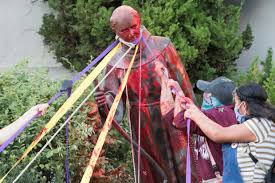
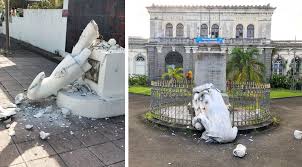
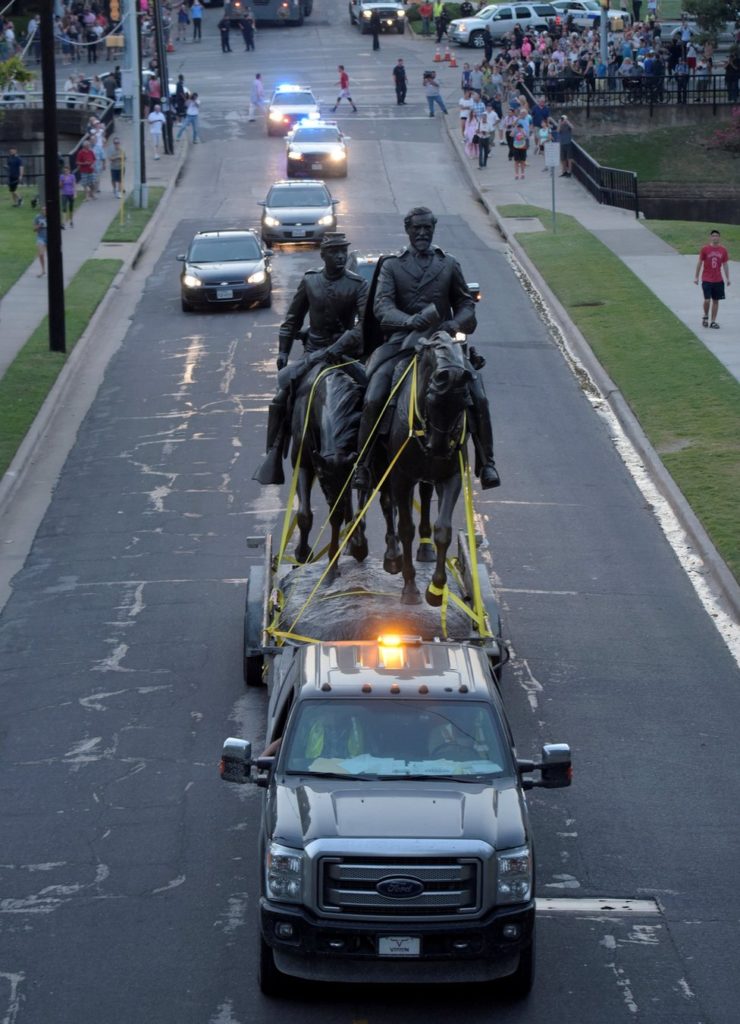
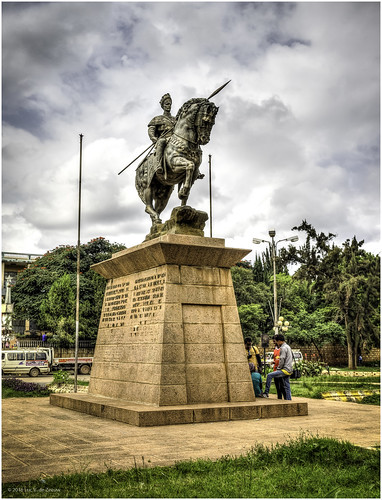
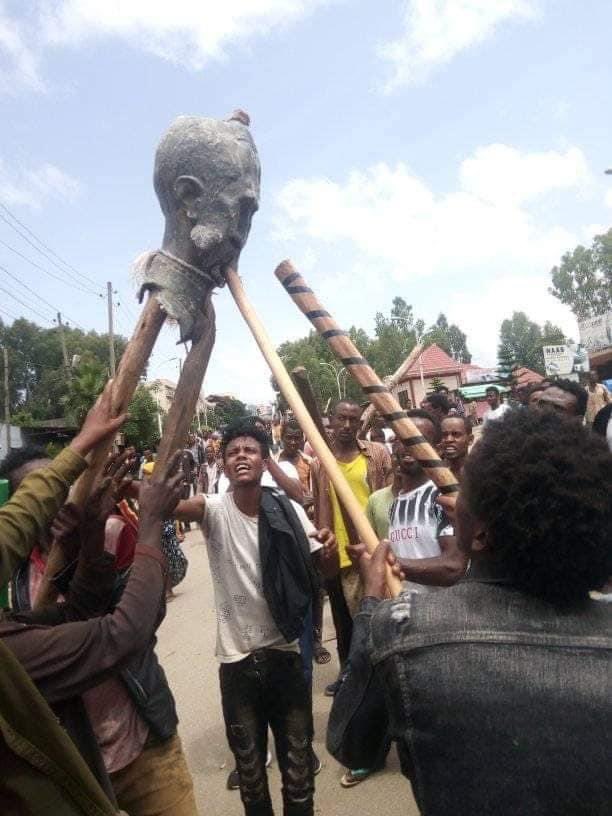

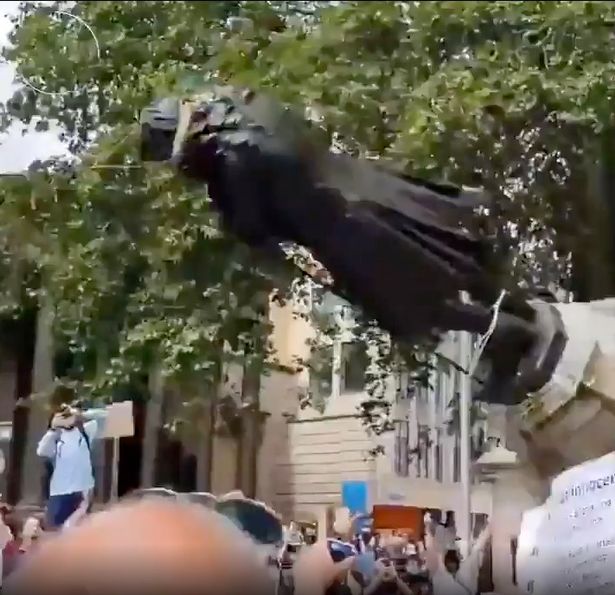
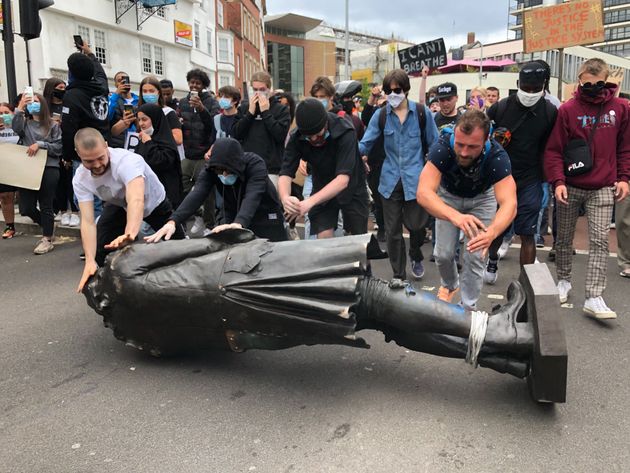
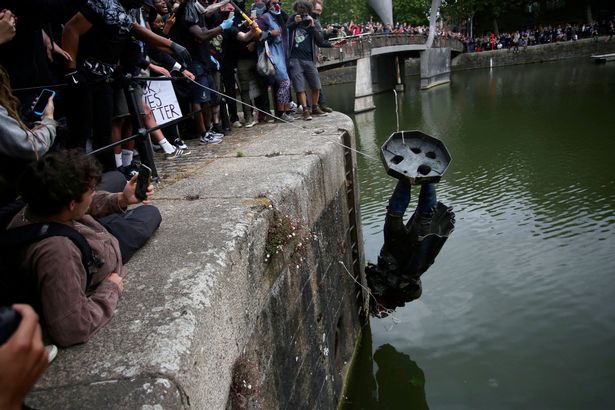


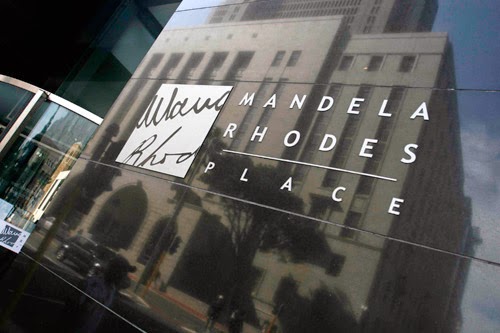
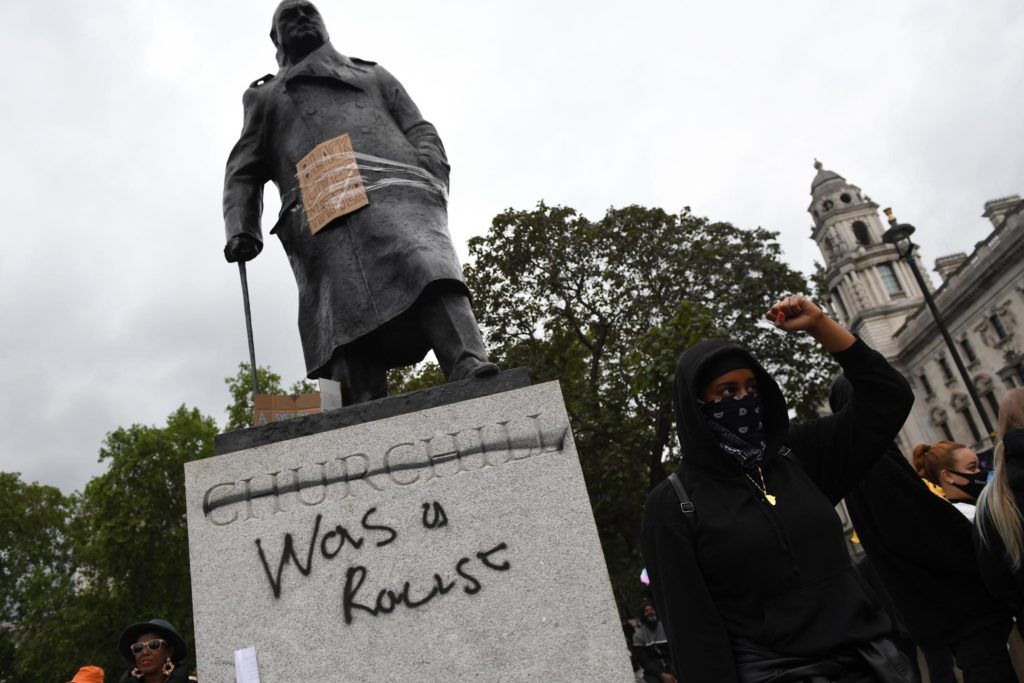
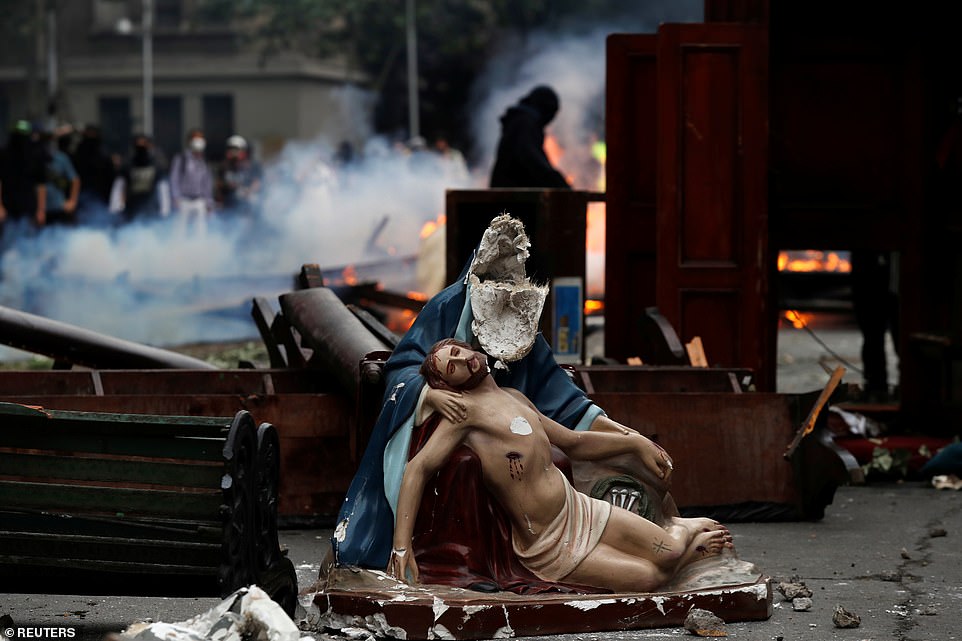


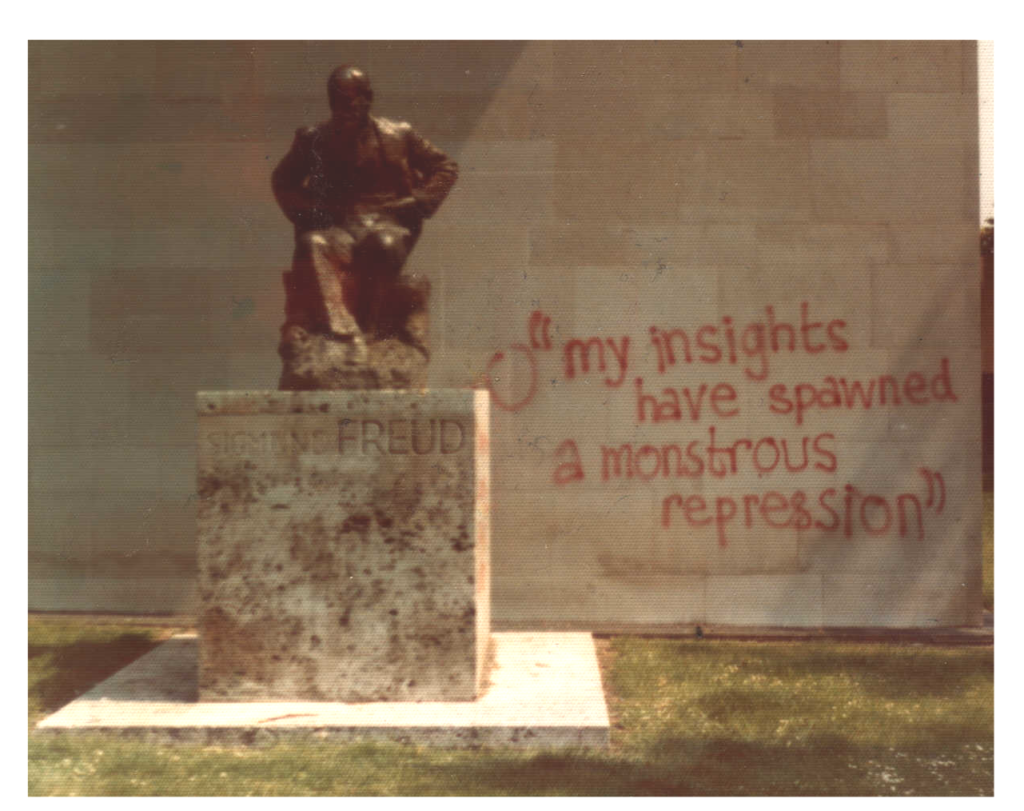

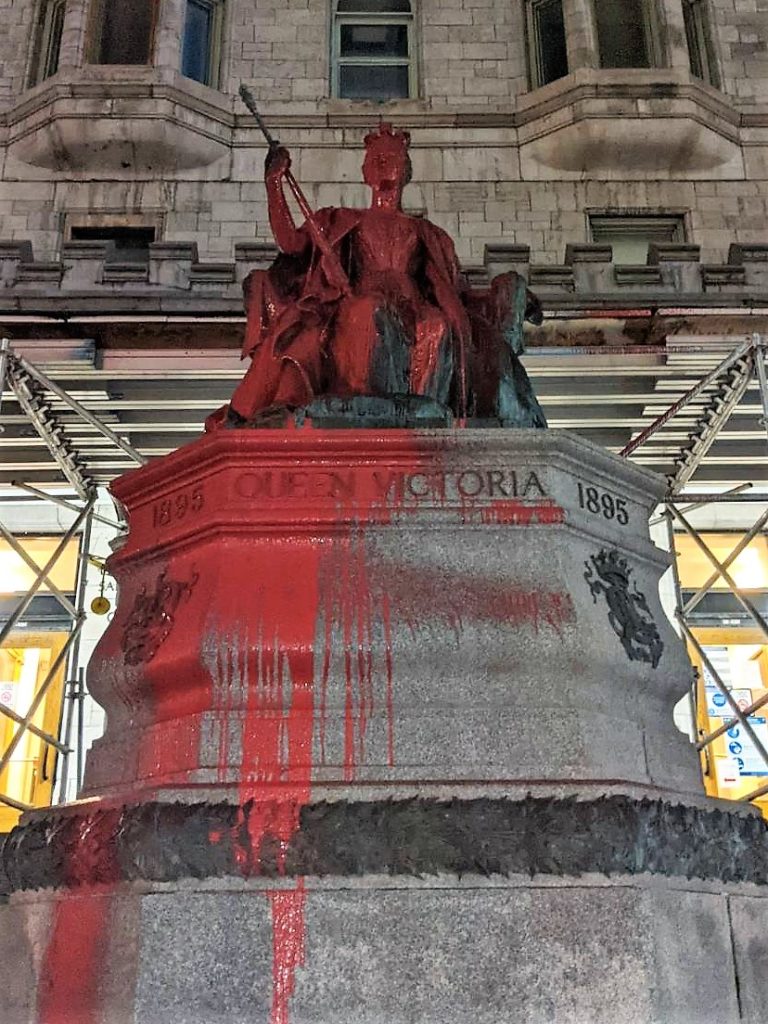
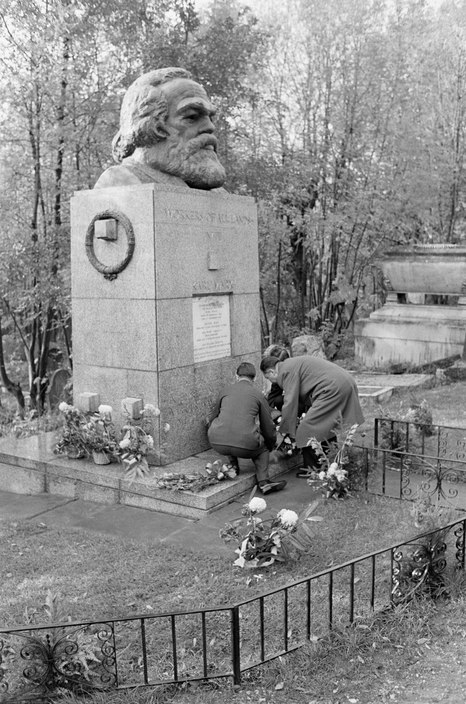
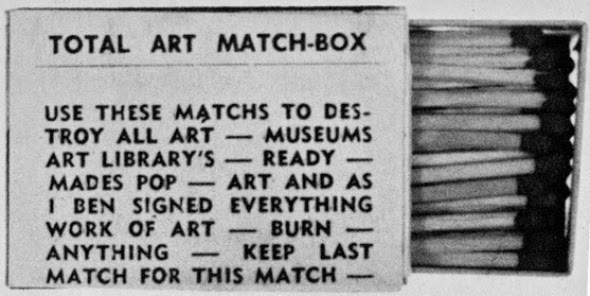
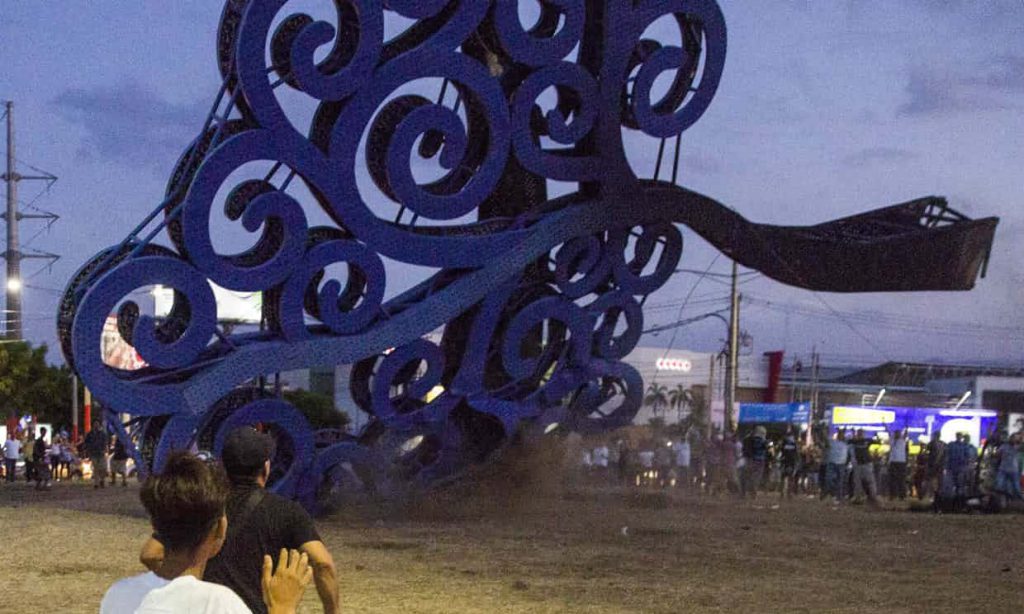
Leave a Reply